Promoting Diversity and Inclusion in the Workplace
VerifiedAdded on 2019/10/09
|23
|9279
|888
Report
AI Summary
The assignment content emphasizes the importance of valuing workplace diversity for promoting a synergistic workplace culture and resolving conflicts effectively. It highlights the benefits of valuing diversity in enhancing business reputation, increasing exposure to employees, and improving productivity. The content also stresses the need to accommodate individual and cultural needs, prevent, overcome, and manage cultural conflicts, as well as develop effective relationships with workmates, clients, and clients' families. To achieve this, it recommends various strategies such as conducting regular discussions, learning about each other's unique attributes, knowing some key phrases of others' languages, avoiding stereotypes, and engaging in self-education.
Contribute Materials
Your contribution can guide someone’s learning journey. Share your
documents today.
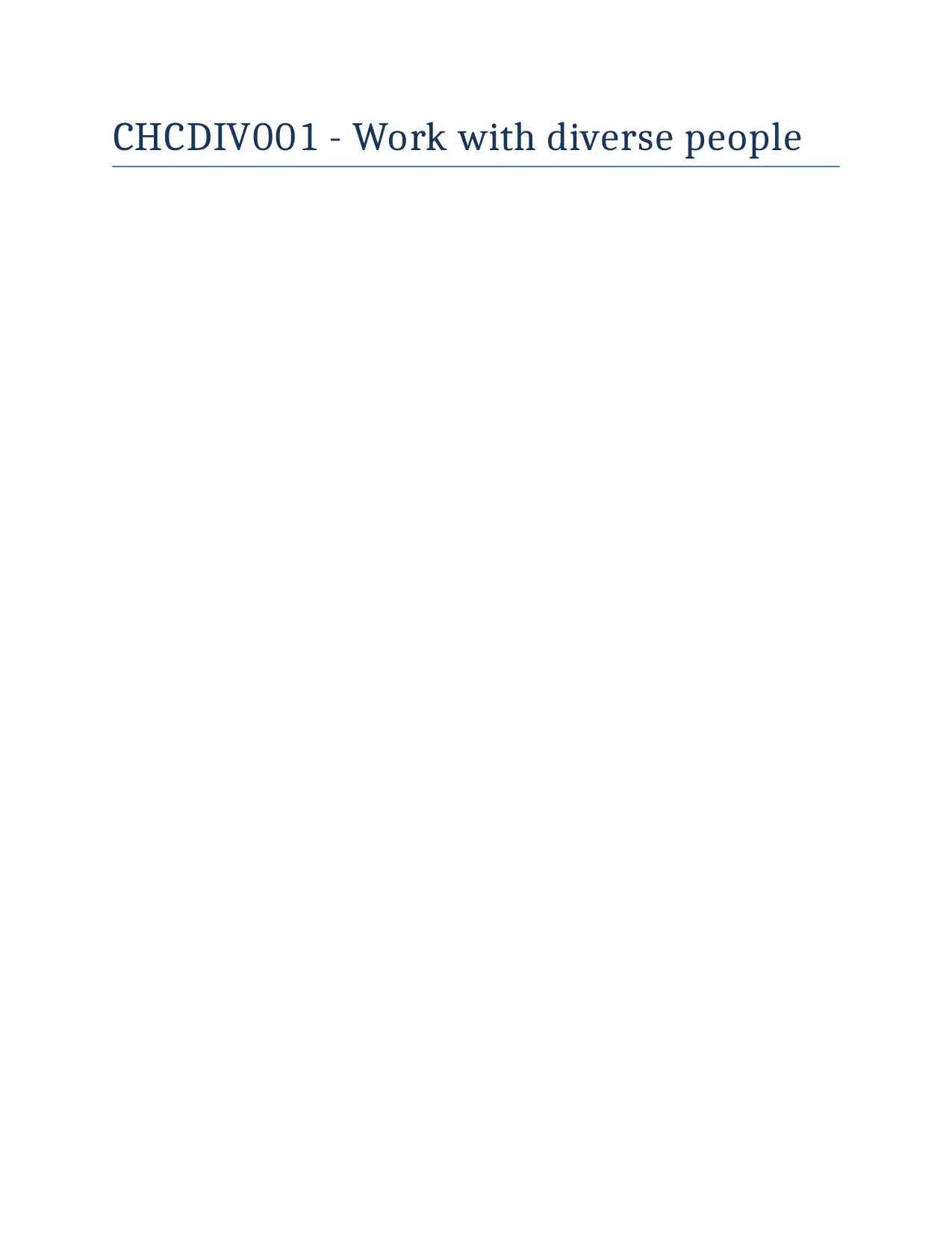
CHCDIV001 - Work with diverse people
Secure Best Marks with AI Grader
Need help grading? Try our AI Grader for instant feedback on your assignments.
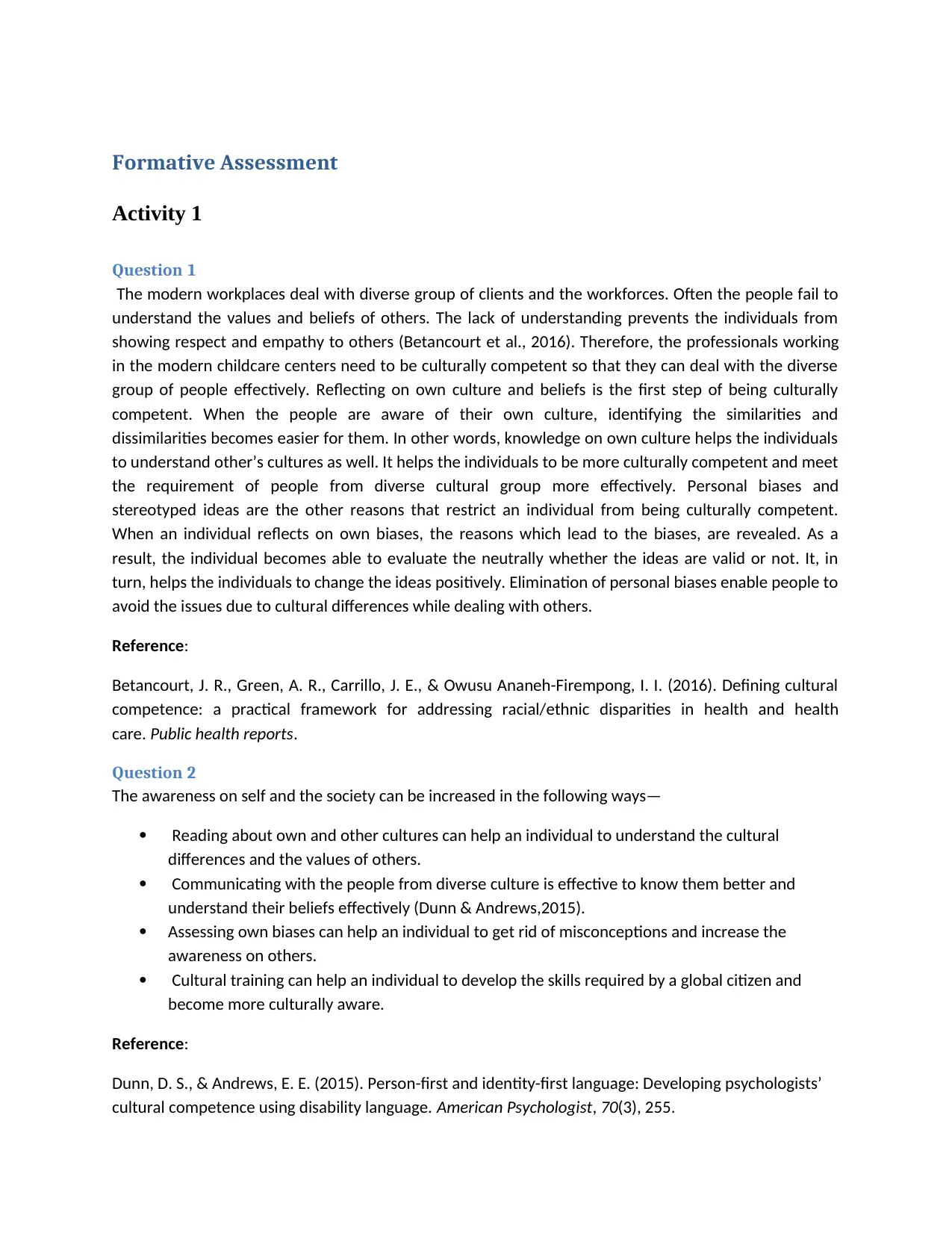
Formative Assessment
Activity 1
Question 1
The modern workplaces deal with diverse group of clients and the workforces. Often the people fail to
understand the values and beliefs of others. The lack of understanding prevents the individuals from
showing respect and empathy to others (Betancourt et al., 2016). Therefore, the professionals working
in the modern childcare centers need to be culturally competent so that they can deal with the diverse
group of people effectively. Reflecting on own culture and beliefs is the first step of being culturally
competent. When the people are aware of their own culture, identifying the similarities and
dissimilarities becomes easier for them. In other words, knowledge on own culture helps the individuals
to understand other’s cultures as well. It helps the individuals to be more culturally competent and meet
the requirement of people from diverse cultural group more effectively. Personal biases and
stereotyped ideas are the other reasons that restrict an individual from being culturally competent.
When an individual reflects on own biases, the reasons which lead to the biases, are revealed. As a
result, the individual becomes able to evaluate the neutrally whether the ideas are valid or not. It, in
turn, helps the individuals to change the ideas positively. Elimination of personal biases enable people to
avoid the issues due to cultural differences while dealing with others.
Reference:
Betancourt, J. R., Green, A. R., Carrillo, J. E., & Owusu Ananeh-Firempong, I. I. (2016). Defining cultural
competence: a practical framework for addressing racial/ethnic disparities in health and health
care. Public health reports.
Question 2
The awareness on self and the society can be increased in the following ways—
Reading about own and other cultures can help an individual to understand the cultural
differences and the values of others.
Communicating with the people from diverse culture is effective to know them better and
understand their beliefs effectively (Dunn & Andrews,2015).
Assessing own biases can help an individual to get rid of misconceptions and increase the
awareness on others.
Cultural training can help an individual to develop the skills required by a global citizen and
become more culturally aware.
Reference:
Dunn, D. S., & Andrews, E. E. (2015). Person-first and identity-first language: Developing psychologists’
cultural competence using disability language. American Psychologist, 70(3), 255.
Activity 1
Question 1
The modern workplaces deal with diverse group of clients and the workforces. Often the people fail to
understand the values and beliefs of others. The lack of understanding prevents the individuals from
showing respect and empathy to others (Betancourt et al., 2016). Therefore, the professionals working
in the modern childcare centers need to be culturally competent so that they can deal with the diverse
group of people effectively. Reflecting on own culture and beliefs is the first step of being culturally
competent. When the people are aware of their own culture, identifying the similarities and
dissimilarities becomes easier for them. In other words, knowledge on own culture helps the individuals
to understand other’s cultures as well. It helps the individuals to be more culturally competent and meet
the requirement of people from diverse cultural group more effectively. Personal biases and
stereotyped ideas are the other reasons that restrict an individual from being culturally competent.
When an individual reflects on own biases, the reasons which lead to the biases, are revealed. As a
result, the individual becomes able to evaluate the neutrally whether the ideas are valid or not. It, in
turn, helps the individuals to change the ideas positively. Elimination of personal biases enable people to
avoid the issues due to cultural differences while dealing with others.
Reference:
Betancourt, J. R., Green, A. R., Carrillo, J. E., & Owusu Ananeh-Firempong, I. I. (2016). Defining cultural
competence: a practical framework for addressing racial/ethnic disparities in health and health
care. Public health reports.
Question 2
The awareness on self and the society can be increased in the following ways—
Reading about own and other cultures can help an individual to understand the cultural
differences and the values of others.
Communicating with the people from diverse culture is effective to know them better and
understand their beliefs effectively (Dunn & Andrews,2015).
Assessing own biases can help an individual to get rid of misconceptions and increase the
awareness on others.
Cultural training can help an individual to develop the skills required by a global citizen and
become more culturally aware.
Reference:
Dunn, D. S., & Andrews, E. E. (2015). Person-first and identity-first language: Developing psychologists’
cultural competence using disability language. American Psychologist, 70(3), 255.
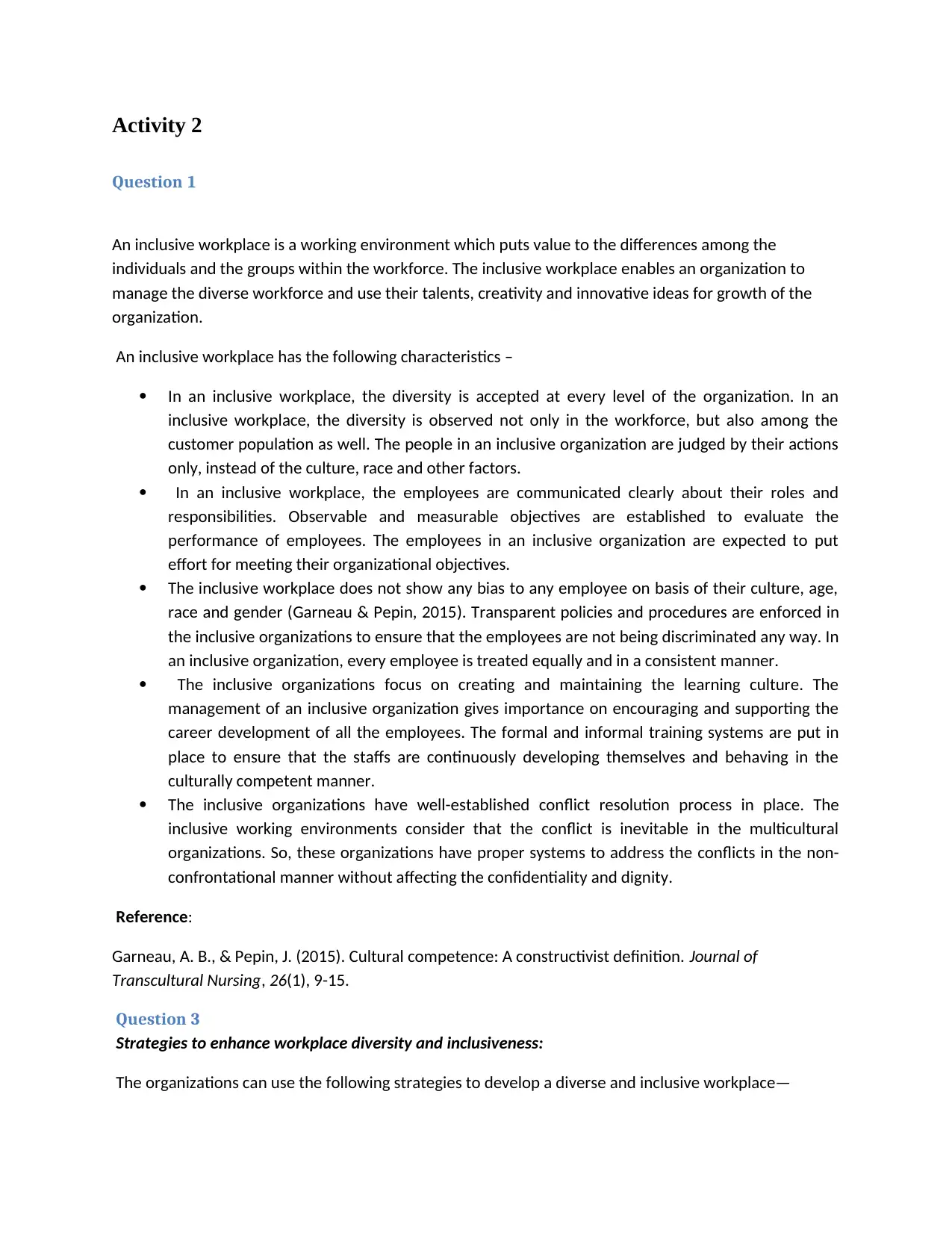
Activity 2
Question 1
An inclusive workplace is a working environment which puts value to the differences among the
individuals and the groups within the workforce. The inclusive workplace enables an organization to
manage the diverse workforce and use their talents, creativity and innovative ideas for growth of the
organization.
An inclusive workplace has the following characteristics –
In an inclusive workplace, the diversity is accepted at every level of the organization. In an
inclusive workplace, the diversity is observed not only in the workforce, but also among the
customer population as well. The people in an inclusive organization are judged by their actions
only, instead of the culture, race and other factors.
In an inclusive workplace, the employees are communicated clearly about their roles and
responsibilities. Observable and measurable objectives are established to evaluate the
performance of employees. The employees in an inclusive organization are expected to put
effort for meeting their organizational objectives.
The inclusive workplace does not show any bias to any employee on basis of their culture, age,
race and gender (Garneau & Pepin, 2015). Transparent policies and procedures are enforced in
the inclusive organizations to ensure that the employees are not being discriminated any way. In
an inclusive organization, every employee is treated equally and in a consistent manner.
The inclusive organizations focus on creating and maintaining the learning culture. The
management of an inclusive organization gives importance on encouraging and supporting the
career development of all the employees. The formal and informal training systems are put in
place to ensure that the staffs are continuously developing themselves and behaving in the
culturally competent manner.
The inclusive organizations have well-established conflict resolution process in place. The
inclusive working environments consider that the conflict is inevitable in the multicultural
organizations. So, these organizations have proper systems to address the conflicts in the non-
confrontational manner without affecting the confidentiality and dignity.
Reference:
Garneau, A. B., & Pepin, J. (2015). Cultural competence: A constructivist definition. Journal of
Transcultural Nursing, 26(1), 9-15.
Question 3
Strategies to enhance workplace diversity and inclusiveness:
The organizations can use the following strategies to develop a diverse and inclusive workplace—
Question 1
An inclusive workplace is a working environment which puts value to the differences among the
individuals and the groups within the workforce. The inclusive workplace enables an organization to
manage the diverse workforce and use their talents, creativity and innovative ideas for growth of the
organization.
An inclusive workplace has the following characteristics –
In an inclusive workplace, the diversity is accepted at every level of the organization. In an
inclusive workplace, the diversity is observed not only in the workforce, but also among the
customer population as well. The people in an inclusive organization are judged by their actions
only, instead of the culture, race and other factors.
In an inclusive workplace, the employees are communicated clearly about their roles and
responsibilities. Observable and measurable objectives are established to evaluate the
performance of employees. The employees in an inclusive organization are expected to put
effort for meeting their organizational objectives.
The inclusive workplace does not show any bias to any employee on basis of their culture, age,
race and gender (Garneau & Pepin, 2015). Transparent policies and procedures are enforced in
the inclusive organizations to ensure that the employees are not being discriminated any way. In
an inclusive organization, every employee is treated equally and in a consistent manner.
The inclusive organizations focus on creating and maintaining the learning culture. The
management of an inclusive organization gives importance on encouraging and supporting the
career development of all the employees. The formal and informal training systems are put in
place to ensure that the staffs are continuously developing themselves and behaving in the
culturally competent manner.
The inclusive organizations have well-established conflict resolution process in place. The
inclusive working environments consider that the conflict is inevitable in the multicultural
organizations. So, these organizations have proper systems to address the conflicts in the non-
confrontational manner without affecting the confidentiality and dignity.
Reference:
Garneau, A. B., & Pepin, J. (2015). Cultural competence: A constructivist definition. Journal of
Transcultural Nursing, 26(1), 9-15.
Question 3
Strategies to enhance workplace diversity and inclusiveness:
The organizations can use the following strategies to develop a diverse and inclusive workplace—
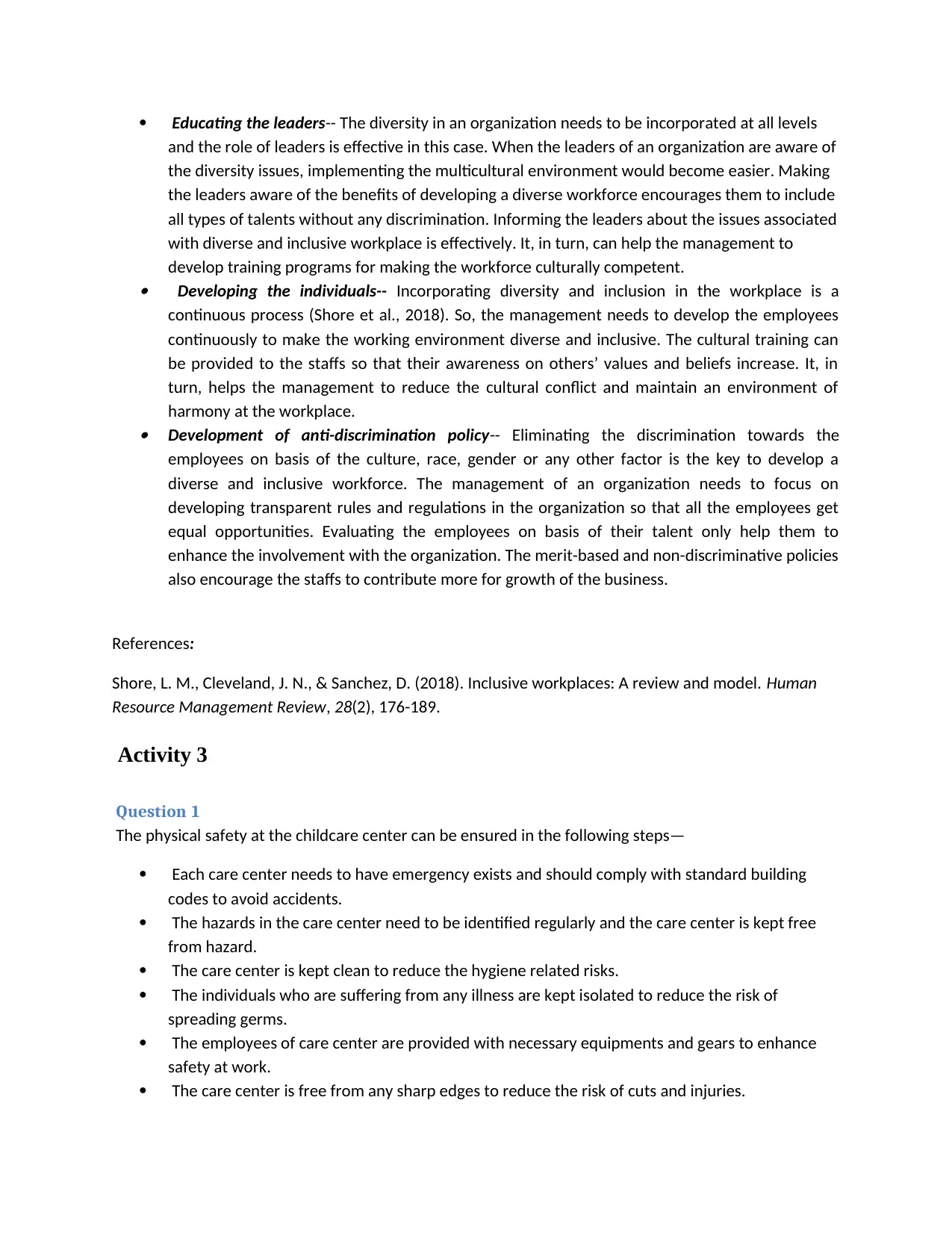
Educating the leaders-- The diversity in an organization needs to be incorporated at all levels
and the role of leaders is effective in this case. When the leaders of an organization are aware of
the diversity issues, implementing the multicultural environment would become easier. Making
the leaders aware of the benefits of developing a diverse workforce encourages them to include
all types of talents without any discrimination. Informing the leaders about the issues associated
with diverse and inclusive workplace is effectively. It, in turn, can help the management to
develop training programs for making the workforce culturally competent.
Developing the individuals-- Incorporating diversity and inclusion in the workplace is a
continuous process (Shore et al., 2018). So, the management needs to develop the employees
continuously to make the working environment diverse and inclusive. The cultural training can
be provided to the staffs so that their awareness on others’ values and beliefs increase. It, in
turn, helps the management to reduce the cultural conflict and maintain an environment of
harmony at the workplace.
Development of anti-discrimination policy-- Eliminating the discrimination towards the
employees on basis of the culture, race, gender or any other factor is the key to develop a
diverse and inclusive workforce. The management of an organization needs to focus on
developing transparent rules and regulations in the organization so that all the employees get
equal opportunities. Evaluating the employees on basis of their talent only help them to
enhance the involvement with the organization. The merit-based and non-discriminative policies
also encourage the staffs to contribute more for growth of the business.
References:
Shore, L. M., Cleveland, J. N., & Sanchez, D. (2018). Inclusive workplaces: A review and model. Human
Resource Management Review, 28(2), 176-189.
Activity 3
Question 1
The physical safety at the childcare center can be ensured in the following steps—
Each care center needs to have emergency exists and should comply with standard building
codes to avoid accidents.
The hazards in the care center need to be identified regularly and the care center is kept free
from hazard.
The care center is kept clean to reduce the hygiene related risks.
The individuals who are suffering from any illness are kept isolated to reduce the risk of
spreading germs.
The employees of care center are provided with necessary equipments and gears to enhance
safety at work.
The care center is free from any sharp edges to reduce the risk of cuts and injuries.
and the role of leaders is effective in this case. When the leaders of an organization are aware of
the diversity issues, implementing the multicultural environment would become easier. Making
the leaders aware of the benefits of developing a diverse workforce encourages them to include
all types of talents without any discrimination. Informing the leaders about the issues associated
with diverse and inclusive workplace is effectively. It, in turn, can help the management to
develop training programs for making the workforce culturally competent.
Developing the individuals-- Incorporating diversity and inclusion in the workplace is a
continuous process (Shore et al., 2018). So, the management needs to develop the employees
continuously to make the working environment diverse and inclusive. The cultural training can
be provided to the staffs so that their awareness on others’ values and beliefs increase. It, in
turn, helps the management to reduce the cultural conflict and maintain an environment of
harmony at the workplace.
Development of anti-discrimination policy-- Eliminating the discrimination towards the
employees on basis of the culture, race, gender or any other factor is the key to develop a
diverse and inclusive workforce. The management of an organization needs to focus on
developing transparent rules and regulations in the organization so that all the employees get
equal opportunities. Evaluating the employees on basis of their talent only help them to
enhance the involvement with the organization. The merit-based and non-discriminative policies
also encourage the staffs to contribute more for growth of the business.
References:
Shore, L. M., Cleveland, J. N., & Sanchez, D. (2018). Inclusive workplaces: A review and model. Human
Resource Management Review, 28(2), 176-189.
Activity 3
Question 1
The physical safety at the childcare center can be ensured in the following steps—
Each care center needs to have emergency exists and should comply with standard building
codes to avoid accidents.
The hazards in the care center need to be identified regularly and the care center is kept free
from hazard.
The care center is kept clean to reduce the hygiene related risks.
The individuals who are suffering from any illness are kept isolated to reduce the risk of
spreading germs.
The employees of care center are provided with necessary equipments and gears to enhance
safety at work.
The care center is free from any sharp edges to reduce the risk of cuts and injuries.
Secure Best Marks with AI Grader
Need help grading? Try our AI Grader for instant feedback on your assignments.
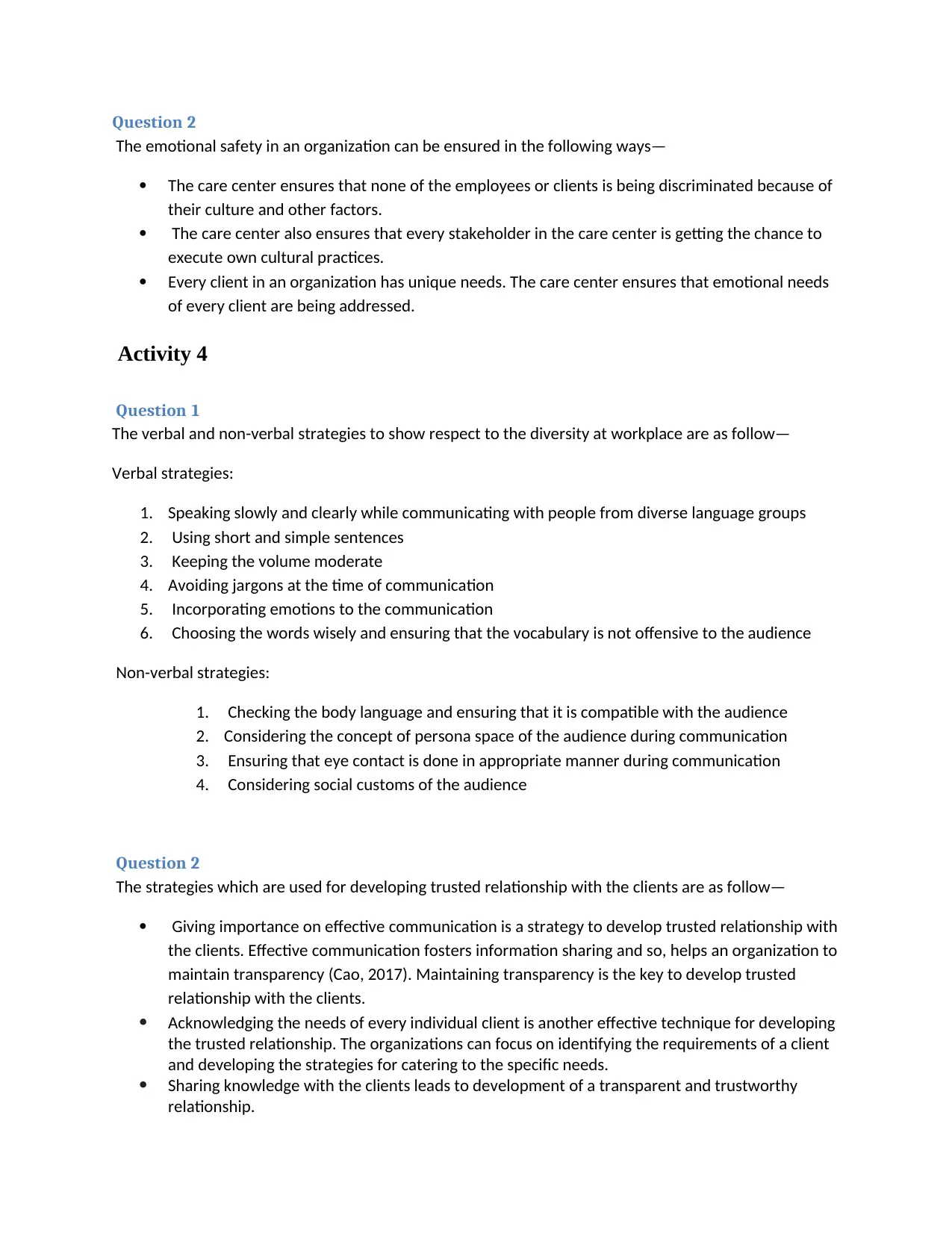
Question 2
The emotional safety in an organization can be ensured in the following ways—
The care center ensures that none of the employees or clients is being discriminated because of
their culture and other factors.
The care center also ensures that every stakeholder in the care center is getting the chance to
execute own cultural practices.
Every client in an organization has unique needs. The care center ensures that emotional needs
of every client are being addressed.
Activity 4
Question 1
The verbal and non-verbal strategies to show respect to the diversity at workplace are as follow—
Verbal strategies:
1. Speaking slowly and clearly while communicating with people from diverse language groups
2. Using short and simple sentences
3. Keeping the volume moderate
4. Avoiding jargons at the time of communication
5. Incorporating emotions to the communication
6. Choosing the words wisely and ensuring that the vocabulary is not offensive to the audience
Non-verbal strategies:
1. Checking the body language and ensuring that it is compatible with the audience
2. Considering the concept of persona space of the audience during communication
3. Ensuring that eye contact is done in appropriate manner during communication
4. Considering social customs of the audience
Question 2
The strategies which are used for developing trusted relationship with the clients are as follow—
Giving importance on effective communication is a strategy to develop trusted relationship with
the clients. Effective communication fosters information sharing and so, helps an organization to
maintain transparency (Cao, 2017). Maintaining transparency is the key to develop trusted
relationship with the clients.
Acknowledging the needs of every individual client is another effective technique for developing
the trusted relationship. The organizations can focus on identifying the requirements of a client
and developing the strategies for catering to the specific needs.
Sharing knowledge with the clients leads to development of a transparent and trustworthy
relationship.
The emotional safety in an organization can be ensured in the following ways—
The care center ensures that none of the employees or clients is being discriminated because of
their culture and other factors.
The care center also ensures that every stakeholder in the care center is getting the chance to
execute own cultural practices.
Every client in an organization has unique needs. The care center ensures that emotional needs
of every client are being addressed.
Activity 4
Question 1
The verbal and non-verbal strategies to show respect to the diversity at workplace are as follow—
Verbal strategies:
1. Speaking slowly and clearly while communicating with people from diverse language groups
2. Using short and simple sentences
3. Keeping the volume moderate
4. Avoiding jargons at the time of communication
5. Incorporating emotions to the communication
6. Choosing the words wisely and ensuring that the vocabulary is not offensive to the audience
Non-verbal strategies:
1. Checking the body language and ensuring that it is compatible with the audience
2. Considering the concept of persona space of the audience during communication
3. Ensuring that eye contact is done in appropriate manner during communication
4. Considering social customs of the audience
Question 2
The strategies which are used for developing trusted relationship with the clients are as follow—
Giving importance on effective communication is a strategy to develop trusted relationship with
the clients. Effective communication fosters information sharing and so, helps an organization to
maintain transparency (Cao, 2017). Maintaining transparency is the key to develop trusted
relationship with the clients.
Acknowledging the needs of every individual client is another effective technique for developing
the trusted relationship. The organizations can focus on identifying the requirements of a client
and developing the strategies for catering to the specific needs.
Sharing knowledge with the clients leads to development of a transparent and trustworthy
relationship.
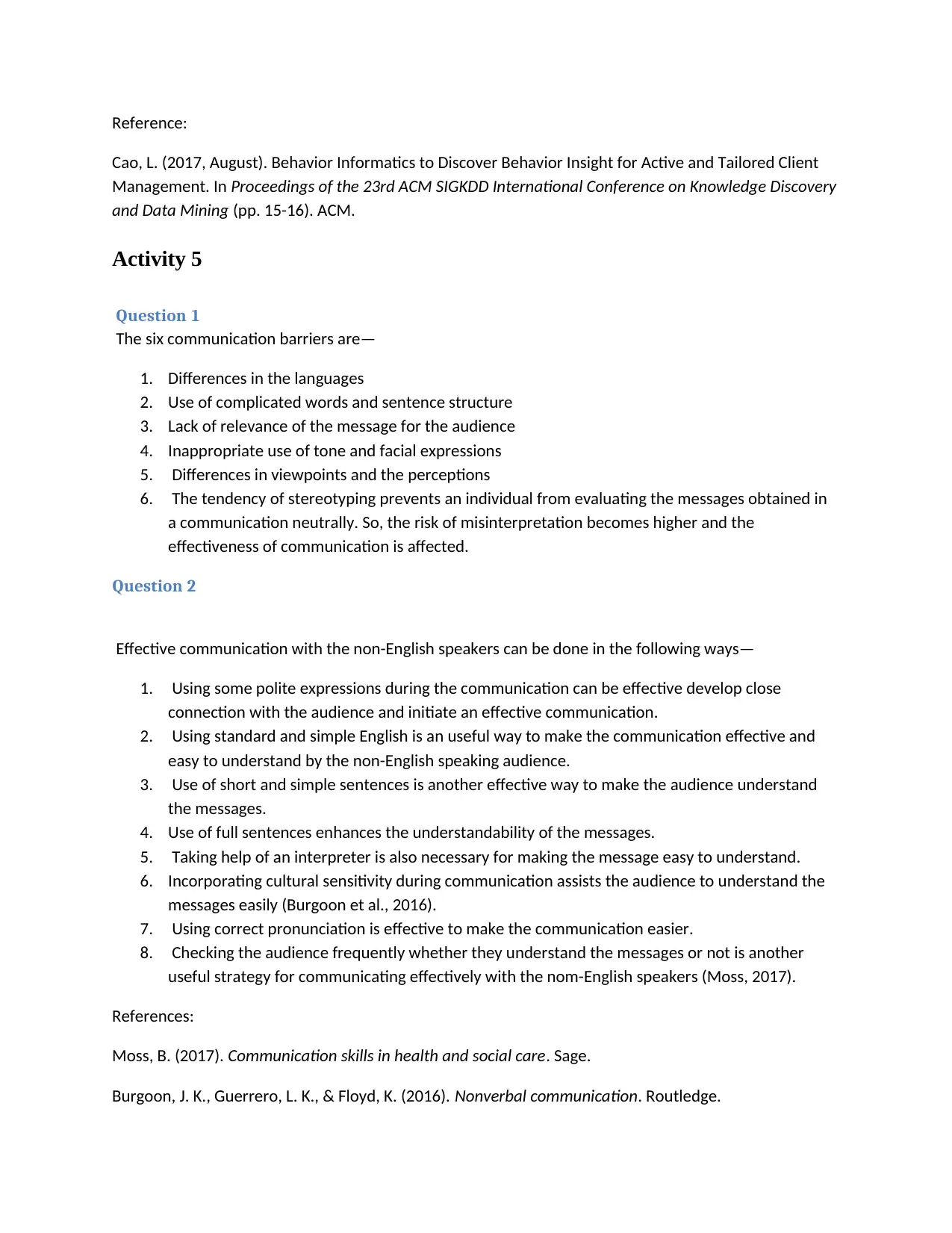
Reference:
Cao, L. (2017, August). Behavior Informatics to Discover Behavior Insight for Active and Tailored Client
Management. In Proceedings of the 23rd ACM SIGKDD International Conference on Knowledge Discovery
and Data Mining (pp. 15-16). ACM.
Activity 5
Question 1
The six communication barriers are—
1. Differences in the languages
2. Use of complicated words and sentence structure
3. Lack of relevance of the message for the audience
4. Inappropriate use of tone and facial expressions
5. Differences in viewpoints and the perceptions
6. The tendency of stereotyping prevents an individual from evaluating the messages obtained in
a communication neutrally. So, the risk of misinterpretation becomes higher and the
effectiveness of communication is affected.
Question 2
Effective communication with the non-English speakers can be done in the following ways—
1. Using some polite expressions during the communication can be effective develop close
connection with the audience and initiate an effective communication.
2. Using standard and simple English is an useful way to make the communication effective and
easy to understand by the non-English speaking audience.
3. Use of short and simple sentences is another effective way to make the audience understand
the messages.
4. Use of full sentences enhances the understandability of the messages.
5. Taking help of an interpreter is also necessary for making the message easy to understand.
6. Incorporating cultural sensitivity during communication assists the audience to understand the
messages easily (Burgoon et al., 2016).
7. Using correct pronunciation is effective to make the communication easier.
8. Checking the audience frequently whether they understand the messages or not is another
useful strategy for communicating effectively with the nom-English speakers (Moss, 2017).
References:
Moss, B. (2017). Communication skills in health and social care. Sage.
Burgoon, J. K., Guerrero, L. K., & Floyd, K. (2016). Nonverbal communication. Routledge.
Cao, L. (2017, August). Behavior Informatics to Discover Behavior Insight for Active and Tailored Client
Management. In Proceedings of the 23rd ACM SIGKDD International Conference on Knowledge Discovery
and Data Mining (pp. 15-16). ACM.
Activity 5
Question 1
The six communication barriers are—
1. Differences in the languages
2. Use of complicated words and sentence structure
3. Lack of relevance of the message for the audience
4. Inappropriate use of tone and facial expressions
5. Differences in viewpoints and the perceptions
6. The tendency of stereotyping prevents an individual from evaluating the messages obtained in
a communication neutrally. So, the risk of misinterpretation becomes higher and the
effectiveness of communication is affected.
Question 2
Effective communication with the non-English speakers can be done in the following ways—
1. Using some polite expressions during the communication can be effective develop close
connection with the audience and initiate an effective communication.
2. Using standard and simple English is an useful way to make the communication effective and
easy to understand by the non-English speaking audience.
3. Use of short and simple sentences is another effective way to make the audience understand
the messages.
4. Use of full sentences enhances the understandability of the messages.
5. Taking help of an interpreter is also necessary for making the message easy to understand.
6. Incorporating cultural sensitivity during communication assists the audience to understand the
messages easily (Burgoon et al., 2016).
7. Using correct pronunciation is effective to make the communication easier.
8. Checking the audience frequently whether they understand the messages or not is another
useful strategy for communicating effectively with the nom-English speakers (Moss, 2017).
References:
Moss, B. (2017). Communication skills in health and social care. Sage.
Burgoon, J. K., Guerrero, L. K., & Floyd, K. (2016). Nonverbal communication. Routledge.

Question 3
The circumstances when using professional interpreter is necessary are—
1. Using professional interpreter is necessary during communicating medical
information to a person who uses English as the second language. Use of the
professional interpreter reduces the risk of any misinterpretation (Betancourt et
al., 2016).
2. The interpreter is necessary while communicating compliance related
information.
3. Using the interpreter is necessary at the time of explaining rights and obligation
related information.
4. Using the interpreter is important when the individual is stressed.
5. The interpreter is necessary at the time of detailed discussion.
Reference:
Betancourt, J. R., Green, A. R., & Carrillo, J. E. (2016). Cross-cultural care and communication. UpToDate,
Waltham, MA: Wolters Kluwer [online].
Activity 6
Question 1
The poor communication in an organization can cause several adverse effects such as poor tem
collaboration, ineffective information sharing, and wastage of time and resource and lower employee
morale.
Question 2
The behaviours that can avoid misunderstanding in a diverse environment are—
1. Increasing cultural awareness and incorporating the knowledge during interaction with others
2. Being polite during communication
3. Using short and simple sentences during communication if the linguistic diversity is high
4. Incorporating the social customs during communication to develop relationship with others
5. Keeping patience and enabling others to adjust with the diverse culture
6. Taking help of interpreters whenever necessary
7. Paying attention to use of right pronunciation
8. Checking the clarity of oral communication continuously and improving the oral communication
Question 3
The circumstances when using professional interpreter is necessary are—
1. Using professional interpreter is necessary during communicating medical
information to a person who uses English as the second language. Use of the
professional interpreter reduces the risk of any misinterpretation (Betancourt et
al., 2016).
2. The interpreter is necessary while communicating compliance related
information.
3. Using the interpreter is necessary at the time of explaining rights and obligation
related information.
4. Using the interpreter is important when the individual is stressed.
5. The interpreter is necessary at the time of detailed discussion.
Reference:
Betancourt, J. R., Green, A. R., & Carrillo, J. E. (2016). Cross-cultural care and communication. UpToDate,
Waltham, MA: Wolters Kluwer [online].
Activity 6
Question 1
The poor communication in an organization can cause several adverse effects such as poor tem
collaboration, ineffective information sharing, and wastage of time and resource and lower employee
morale.
Question 2
The behaviours that can avoid misunderstanding in a diverse environment are—
1. Increasing cultural awareness and incorporating the knowledge during interaction with others
2. Being polite during communication
3. Using short and simple sentences during communication if the linguistic diversity is high
4. Incorporating the social customs during communication to develop relationship with others
5. Keeping patience and enabling others to adjust with the diverse culture
6. Taking help of interpreters whenever necessary
7. Paying attention to use of right pronunciation
8. Checking the clarity of oral communication continuously and improving the oral communication
Question 3
Paraphrase This Document
Need a fresh take? Get an instant paraphrase of this document with our AI Paraphraser
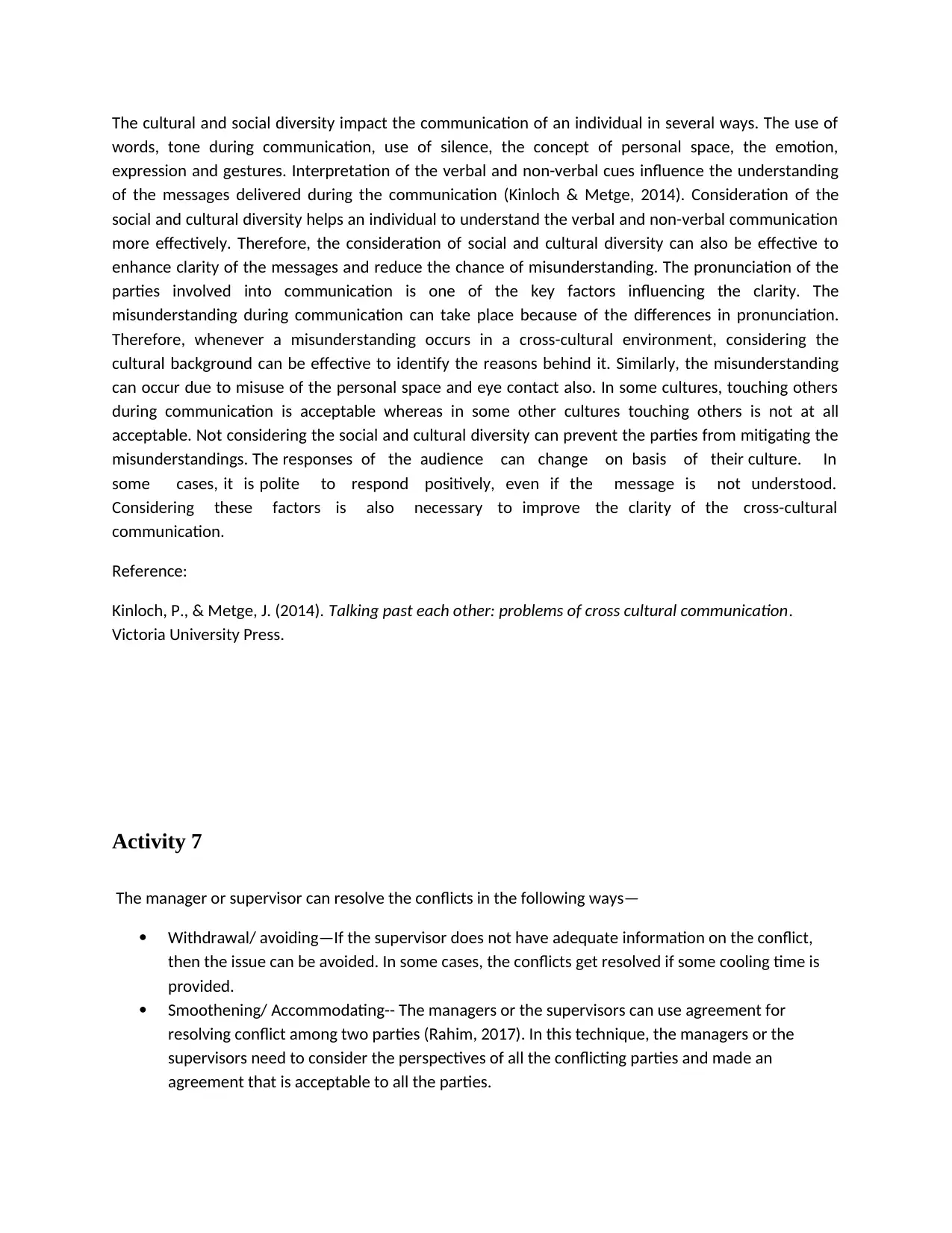
The cultural and social diversity impact the communication of an individual in several ways. The use of
words, tone during communication, use of silence, the concept of personal space, the emotion,
expression and gestures. Interpretation of the verbal and non-verbal cues influence the understanding
of the messages delivered during the communication (Kinloch & Metge, 2014). Consideration of the
social and cultural diversity helps an individual to understand the verbal and non-verbal communication
more effectively. Therefore, the consideration of social and cultural diversity can also be effective to
enhance clarity of the messages and reduce the chance of misunderstanding. The pronunciation of the
parties involved into communication is one of the key factors influencing the clarity. The
misunderstanding during communication can take place because of the differences in pronunciation.
Therefore, whenever a misunderstanding occurs in a cross-cultural environment, considering the
cultural background can be effective to identify the reasons behind it. Similarly, the misunderstanding
can occur due to misuse of the personal space and eye contact also. In some cultures, touching others
during communication is acceptable whereas in some other cultures touching others is not at all
acceptable. Not considering the social and cultural diversity can prevent the parties from mitigating the
misunderstandings. The responses of the audience can change on basis of their culture. In
some cases, it is polite to respond positively, even if the message is not understood.
Considering these factors is also necessary to improve the clarity of the cross-cultural
communication.
Reference:
Kinloch, P., & Metge, J. (2014). Talking past each other: problems of cross cultural communication.
Victoria University Press.
Activity 7
The manager or supervisor can resolve the conflicts in the following ways—
Withdrawal/ avoiding—If the supervisor does not have adequate information on the conflict,
then the issue can be avoided. In some cases, the conflicts get resolved if some cooling time is
provided.
Smoothening/ Accommodating-- The managers or the supervisors can use agreement for
resolving conflict among two parties (Rahim, 2017). In this technique, the managers or the
supervisors need to consider the perspectives of all the conflicting parties and made an
agreement that is acceptable to all the parties.
words, tone during communication, use of silence, the concept of personal space, the emotion,
expression and gestures. Interpretation of the verbal and non-verbal cues influence the understanding
of the messages delivered during the communication (Kinloch & Metge, 2014). Consideration of the
social and cultural diversity helps an individual to understand the verbal and non-verbal communication
more effectively. Therefore, the consideration of social and cultural diversity can also be effective to
enhance clarity of the messages and reduce the chance of misunderstanding. The pronunciation of the
parties involved into communication is one of the key factors influencing the clarity. The
misunderstanding during communication can take place because of the differences in pronunciation.
Therefore, whenever a misunderstanding occurs in a cross-cultural environment, considering the
cultural background can be effective to identify the reasons behind it. Similarly, the misunderstanding
can occur due to misuse of the personal space and eye contact also. In some cultures, touching others
during communication is acceptable whereas in some other cultures touching others is not at all
acceptable. Not considering the social and cultural diversity can prevent the parties from mitigating the
misunderstandings. The responses of the audience can change on basis of their culture. In
some cases, it is polite to respond positively, even if the message is not understood.
Considering these factors is also necessary to improve the clarity of the cross-cultural
communication.
Reference:
Kinloch, P., & Metge, J. (2014). Talking past each other: problems of cross cultural communication.
Victoria University Press.
Activity 7
The manager or supervisor can resolve the conflicts in the following ways—
Withdrawal/ avoiding—If the supervisor does not have adequate information on the conflict,
then the issue can be avoided. In some cases, the conflicts get resolved if some cooling time is
provided.
Smoothening/ Accommodating-- The managers or the supervisors can use agreement for
resolving conflict among two parties (Rahim, 2017). In this technique, the managers or the
supervisors need to consider the perspectives of all the conflicting parties and made an
agreement that is acceptable to all the parties.
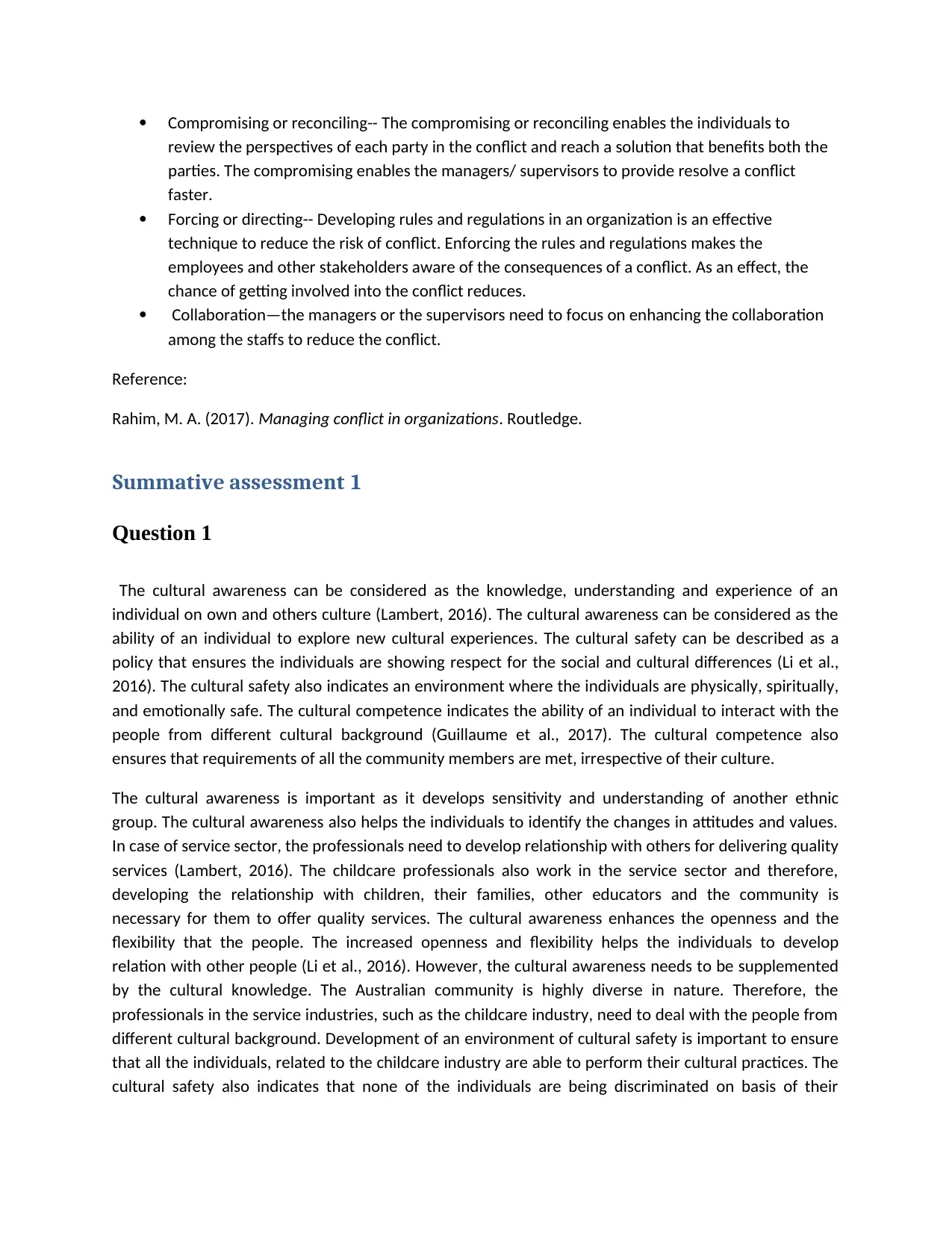
Compromising or reconciling-- The compromising or reconciling enables the individuals to
review the perspectives of each party in the conflict and reach a solution that benefits both the
parties. The compromising enables the managers/ supervisors to provide resolve a conflict
faster.
Forcing or directing-- Developing rules and regulations in an organization is an effective
technique to reduce the risk of conflict. Enforcing the rules and regulations makes the
employees and other stakeholders aware of the consequences of a conflict. As an effect, the
chance of getting involved into the conflict reduces.
Collaboration—the managers or the supervisors need to focus on enhancing the collaboration
among the staffs to reduce the conflict.
Reference:
Rahim, M. A. (2017). Managing conflict in organizations. Routledge.
Summative assessment 1
Question 1
The cultural awareness can be considered as the knowledge, understanding and experience of an
individual on own and others culture (Lambert, 2016). The cultural awareness can be considered as the
ability of an individual to explore new cultural experiences. The cultural safety can be described as a
policy that ensures the individuals are showing respect for the social and cultural differences (Li et al.,
2016). The cultural safety also indicates an environment where the individuals are physically, spiritually,
and emotionally safe. The cultural competence indicates the ability of an individual to interact with the
people from different cultural background (Guillaume et al., 2017). The cultural competence also
ensures that requirements of all the community members are met, irrespective of their culture.
The cultural awareness is important as it develops sensitivity and understanding of another ethnic
group. The cultural awareness also helps the individuals to identify the changes in attitudes and values.
In case of service sector, the professionals need to develop relationship with others for delivering quality
services (Lambert, 2016). The childcare professionals also work in the service sector and therefore,
developing the relationship with children, their families, other educators and the community is
necessary for them to offer quality services. The cultural awareness enhances the openness and the
flexibility that the people. The increased openness and flexibility helps the individuals to develop
relation with other people (Li et al., 2016). However, the cultural awareness needs to be supplemented
by the cultural knowledge. The Australian community is highly diverse in nature. Therefore, the
professionals in the service industries, such as the childcare industry, need to deal with the people from
different cultural background. Development of an environment of cultural safety is important to ensure
that all the individuals, related to the childcare industry are able to perform their cultural practices. The
cultural safety also indicates that none of the individuals are being discriminated on basis of their
review the perspectives of each party in the conflict and reach a solution that benefits both the
parties. The compromising enables the managers/ supervisors to provide resolve a conflict
faster.
Forcing or directing-- Developing rules and regulations in an organization is an effective
technique to reduce the risk of conflict. Enforcing the rules and regulations makes the
employees and other stakeholders aware of the consequences of a conflict. As an effect, the
chance of getting involved into the conflict reduces.
Collaboration—the managers or the supervisors need to focus on enhancing the collaboration
among the staffs to reduce the conflict.
Reference:
Rahim, M. A. (2017). Managing conflict in organizations. Routledge.
Summative assessment 1
Question 1
The cultural awareness can be considered as the knowledge, understanding and experience of an
individual on own and others culture (Lambert, 2016). The cultural awareness can be considered as the
ability of an individual to explore new cultural experiences. The cultural safety can be described as a
policy that ensures the individuals are showing respect for the social and cultural differences (Li et al.,
2016). The cultural safety also indicates an environment where the individuals are physically, spiritually,
and emotionally safe. The cultural competence indicates the ability of an individual to interact with the
people from different cultural background (Guillaume et al., 2017). The cultural competence also
ensures that requirements of all the community members are met, irrespective of their culture.
The cultural awareness is important as it develops sensitivity and understanding of another ethnic
group. The cultural awareness also helps the individuals to identify the changes in attitudes and values.
In case of service sector, the professionals need to develop relationship with others for delivering quality
services (Lambert, 2016). The childcare professionals also work in the service sector and therefore,
developing the relationship with children, their families, other educators and the community is
necessary for them to offer quality services. The cultural awareness enhances the openness and the
flexibility that the people. The increased openness and flexibility helps the individuals to develop
relation with other people (Li et al., 2016). However, the cultural awareness needs to be supplemented
by the cultural knowledge. The Australian community is highly diverse in nature. Therefore, the
professionals in the service industries, such as the childcare industry, need to deal with the people from
different cultural background. Development of an environment of cultural safety is important to ensure
that all the individuals, related to the childcare industry are able to perform their cultural practices. The
cultural safety also indicates that none of the individuals are being discriminated on basis of their
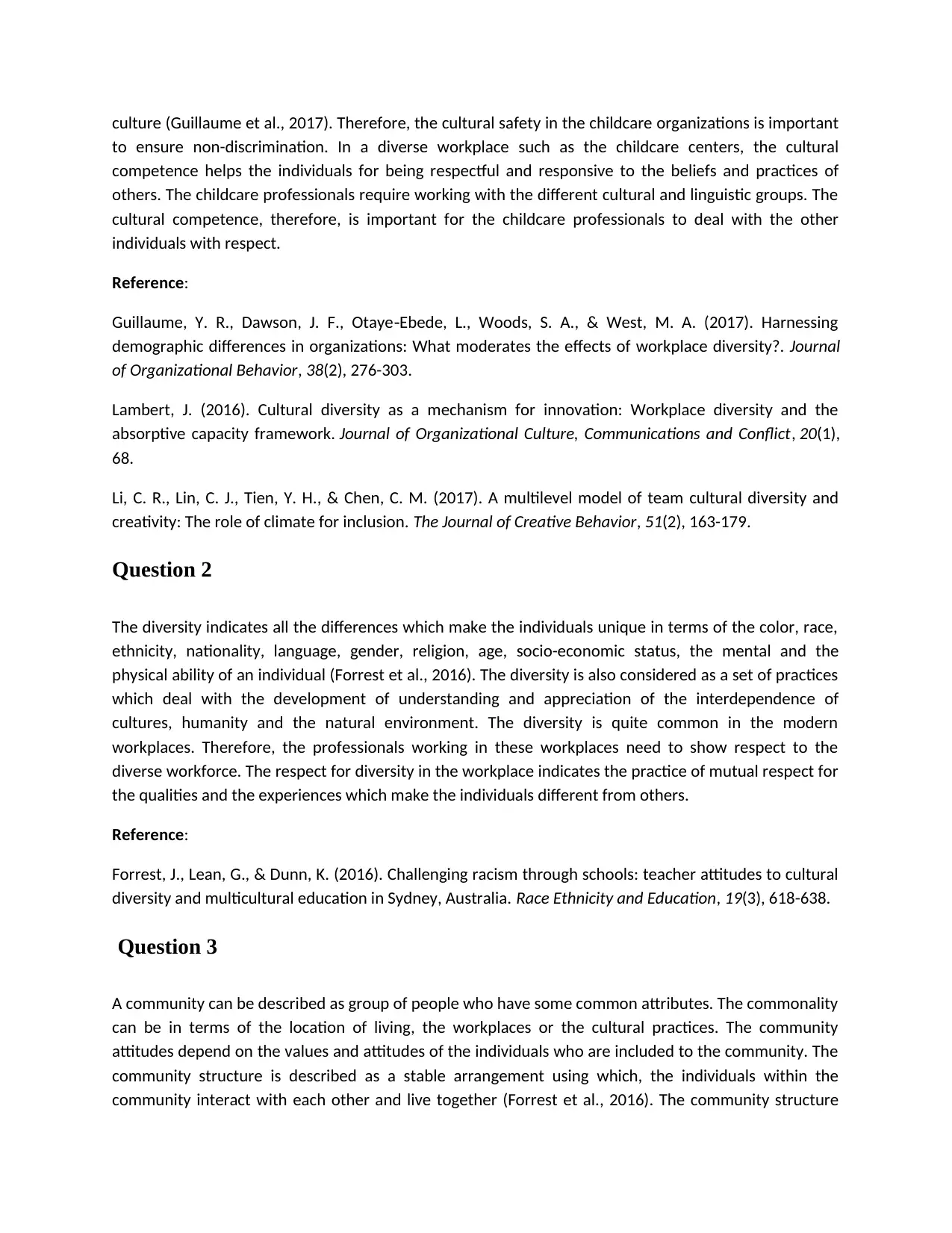
culture (Guillaume et al., 2017). Therefore, the cultural safety in the childcare organizations is important
to ensure non-discrimination. In a diverse workplace such as the childcare centers, the cultural
competence helps the individuals for being respectful and responsive to the beliefs and practices of
others. The childcare professionals require working with the different cultural and linguistic groups. The
cultural competence, therefore, is important for the childcare professionals to deal with the other
individuals with respect.
Reference:
Guillaume, Y. R., Dawson, J. F., Otaye Ebede, L., Woods, S. A., & West, M. A. (2017). Harnessing‐
demographic differences in organizations: What moderates the effects of workplace diversity?. Journal
of Organizational Behavior, 38(2), 276-303.
Lambert, J. (2016). Cultural diversity as a mechanism for innovation: Workplace diversity and the
absorptive capacity framework. Journal of Organizational Culture, Communications and Conflict, 20(1),
68.
Li, C. R., Lin, C. J., Tien, Y. H., & Chen, C. M. (2017). A multilevel model of team cultural diversity and
creativity: The role of climate for inclusion. The Journal of Creative Behavior, 51(2), 163-179.
Question 2
The diversity indicates all the differences which make the individuals unique in terms of the color, race,
ethnicity, nationality, language, gender, religion, age, socio-economic status, the mental and the
physical ability of an individual (Forrest et al., 2016). The diversity is also considered as a set of practices
which deal with the development of understanding and appreciation of the interdependence of
cultures, humanity and the natural environment. The diversity is quite common in the modern
workplaces. Therefore, the professionals working in these workplaces need to show respect to the
diverse workforce. The respect for diversity in the workplace indicates the practice of mutual respect for
the qualities and the experiences which make the individuals different from others.
Reference:
Forrest, J., Lean, G., & Dunn, K. (2016). Challenging racism through schools: teacher attitudes to cultural
diversity and multicultural education in Sydney, Australia. Race Ethnicity and Education, 19(3), 618-638.
Question 3
A community can be described as group of people who have some common attributes. The commonality
can be in terms of the location of living, the workplaces or the cultural practices. The community
attitudes depend on the values and attitudes of the individuals who are included to the community. The
community structure is described as a stable arrangement using which, the individuals within the
community interact with each other and live together (Forrest et al., 2016). The community structure
to ensure non-discrimination. In a diverse workplace such as the childcare centers, the cultural
competence helps the individuals for being respectful and responsive to the beliefs and practices of
others. The childcare professionals require working with the different cultural and linguistic groups. The
cultural competence, therefore, is important for the childcare professionals to deal with the other
individuals with respect.
Reference:
Guillaume, Y. R., Dawson, J. F., Otaye Ebede, L., Woods, S. A., & West, M. A. (2017). Harnessing‐
demographic differences in organizations: What moderates the effects of workplace diversity?. Journal
of Organizational Behavior, 38(2), 276-303.
Lambert, J. (2016). Cultural diversity as a mechanism for innovation: Workplace diversity and the
absorptive capacity framework. Journal of Organizational Culture, Communications and Conflict, 20(1),
68.
Li, C. R., Lin, C. J., Tien, Y. H., & Chen, C. M. (2017). A multilevel model of team cultural diversity and
creativity: The role of climate for inclusion. The Journal of Creative Behavior, 51(2), 163-179.
Question 2
The diversity indicates all the differences which make the individuals unique in terms of the color, race,
ethnicity, nationality, language, gender, religion, age, socio-economic status, the mental and the
physical ability of an individual (Forrest et al., 2016). The diversity is also considered as a set of practices
which deal with the development of understanding and appreciation of the interdependence of
cultures, humanity and the natural environment. The diversity is quite common in the modern
workplaces. Therefore, the professionals working in these workplaces need to show respect to the
diverse workforce. The respect for diversity in the workplace indicates the practice of mutual respect for
the qualities and the experiences which make the individuals different from others.
Reference:
Forrest, J., Lean, G., & Dunn, K. (2016). Challenging racism through schools: teacher attitudes to cultural
diversity and multicultural education in Sydney, Australia. Race Ethnicity and Education, 19(3), 618-638.
Question 3
A community can be described as group of people who have some common attributes. The commonality
can be in terms of the location of living, the workplaces or the cultural practices. The community
attitudes depend on the values and attitudes of the individuals who are included to the community. The
community structure is described as a stable arrangement using which, the individuals within the
community interact with each other and live together (Forrest et al., 2016). The community structure
Secure Best Marks with AI Grader
Need help grading? Try our AI Grader for instant feedback on your assignments.
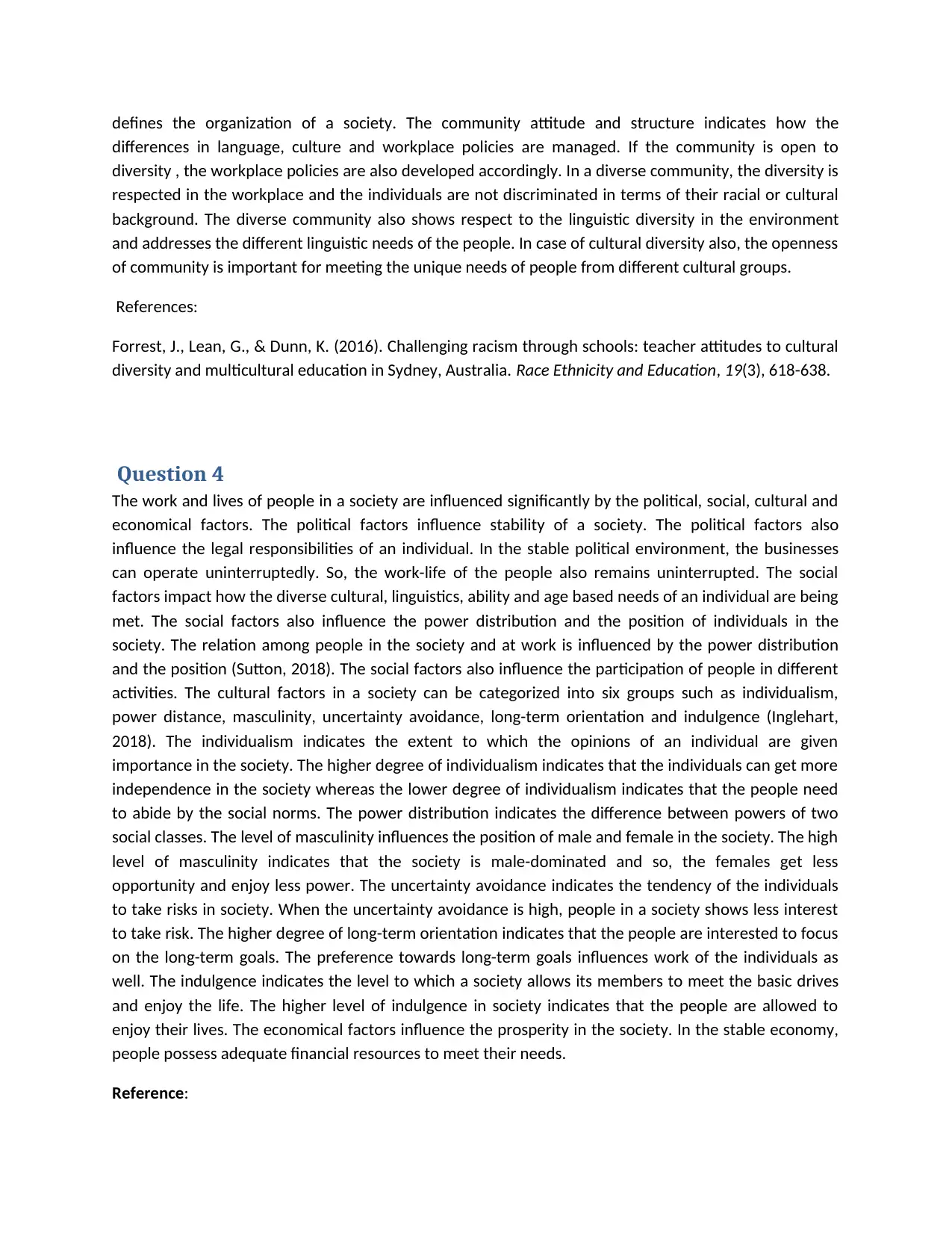
defines the organization of a society. The community attitude and structure indicates how the
differences in language, culture and workplace policies are managed. If the community is open to
diversity , the workplace policies are also developed accordingly. In a diverse community, the diversity is
respected in the workplace and the individuals are not discriminated in terms of their racial or cultural
background. The diverse community also shows respect to the linguistic diversity in the environment
and addresses the different linguistic needs of the people. In case of cultural diversity also, the openness
of community is important for meeting the unique needs of people from different cultural groups.
References:
Forrest, J., Lean, G., & Dunn, K. (2016). Challenging racism through schools: teacher attitudes to cultural
diversity and multicultural education in Sydney, Australia. Race Ethnicity and Education, 19(3), 618-638.
Question 4
The work and lives of people in a society are influenced significantly by the political, social, cultural and
economical factors. The political factors influence stability of a society. The political factors also
influence the legal responsibilities of an individual. In the stable political environment, the businesses
can operate uninterruptedly. So, the work-life of the people also remains uninterrupted. The social
factors impact how the diverse cultural, linguistics, ability and age based needs of an individual are being
met. The social factors also influence the power distribution and the position of individuals in the
society. The relation among people in the society and at work is influenced by the power distribution
and the position (Sutton, 2018). The social factors also influence the participation of people in different
activities. The cultural factors in a society can be categorized into six groups such as individualism,
power distance, masculinity, uncertainty avoidance, long-term orientation and indulgence (Inglehart,
2018). The individualism indicates the extent to which the opinions of an individual are given
importance in the society. The higher degree of individualism indicates that the individuals can get more
independence in the society whereas the lower degree of individualism indicates that the people need
to abide by the social norms. The power distribution indicates the difference between powers of two
social classes. The level of masculinity influences the position of male and female in the society. The high
level of masculinity indicates that the society is male-dominated and so, the females get less
opportunity and enjoy less power. The uncertainty avoidance indicates the tendency of the individuals
to take risks in society. When the uncertainty avoidance is high, people in a society shows less interest
to take risk. The higher degree of long-term orientation indicates that the people are interested to focus
on the long-term goals. The preference towards long-term goals influences work of the individuals as
well. The indulgence indicates the level to which a society allows its members to meet the basic drives
and enjoy the life. The higher level of indulgence in society indicates that the people are allowed to
enjoy their lives. The economical factors influence the prosperity in the society. In the stable economy,
people possess adequate financial resources to meet their needs.
Reference:
differences in language, culture and workplace policies are managed. If the community is open to
diversity , the workplace policies are also developed accordingly. In a diverse community, the diversity is
respected in the workplace and the individuals are not discriminated in terms of their racial or cultural
background. The diverse community also shows respect to the linguistic diversity in the environment
and addresses the different linguistic needs of the people. In case of cultural diversity also, the openness
of community is important for meeting the unique needs of people from different cultural groups.
References:
Forrest, J., Lean, G., & Dunn, K. (2016). Challenging racism through schools: teacher attitudes to cultural
diversity and multicultural education in Sydney, Australia. Race Ethnicity and Education, 19(3), 618-638.
Question 4
The work and lives of people in a society are influenced significantly by the political, social, cultural and
economical factors. The political factors influence stability of a society. The political factors also
influence the legal responsibilities of an individual. In the stable political environment, the businesses
can operate uninterruptedly. So, the work-life of the people also remains uninterrupted. The social
factors impact how the diverse cultural, linguistics, ability and age based needs of an individual are being
met. The social factors also influence the power distribution and the position of individuals in the
society. The relation among people in the society and at work is influenced by the power distribution
and the position (Sutton, 2018). The social factors also influence the participation of people in different
activities. The cultural factors in a society can be categorized into six groups such as individualism,
power distance, masculinity, uncertainty avoidance, long-term orientation and indulgence (Inglehart,
2018). The individualism indicates the extent to which the opinions of an individual are given
importance in the society. The higher degree of individualism indicates that the individuals can get more
independence in the society whereas the lower degree of individualism indicates that the people need
to abide by the social norms. The power distribution indicates the difference between powers of two
social classes. The level of masculinity influences the position of male and female in the society. The high
level of masculinity indicates that the society is male-dominated and so, the females get less
opportunity and enjoy less power. The uncertainty avoidance indicates the tendency of the individuals
to take risks in society. When the uncertainty avoidance is high, people in a society shows less interest
to take risk. The higher degree of long-term orientation indicates that the people are interested to focus
on the long-term goals. The preference towards long-term goals influences work of the individuals as
well. The indulgence indicates the level to which a society allows its members to meet the basic drives
and enjoy the life. The higher level of indulgence in society indicates that the people are allowed to
enjoy their lives. The economical factors influence the prosperity in the society. In the stable economy,
people possess adequate financial resources to meet their needs.
Reference:
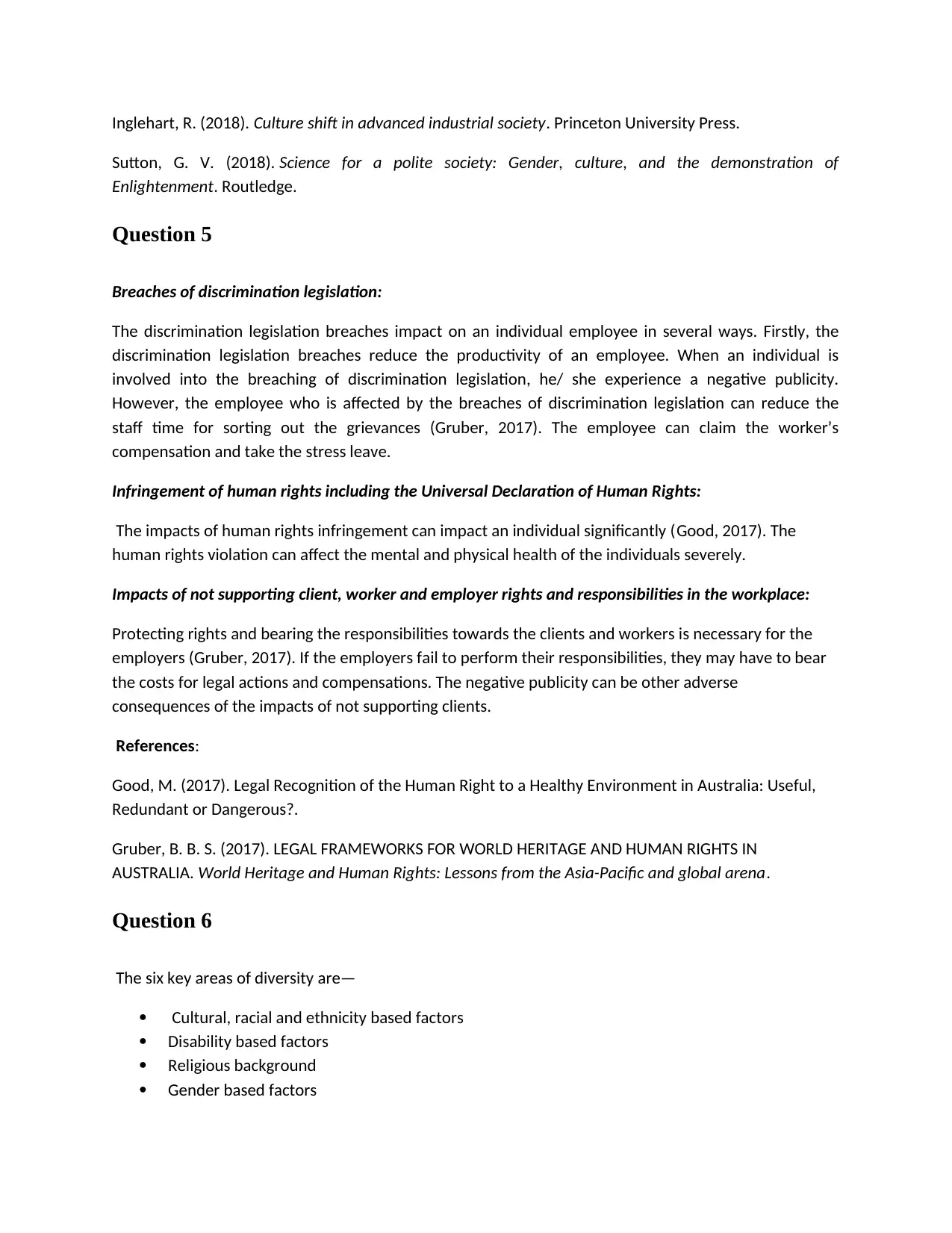
Inglehart, R. (2018). Culture shift in advanced industrial society. Princeton University Press.
Sutton, G. V. (2018). Science for a polite society: Gender, culture, and the demonstration of
Enlightenment. Routledge.
Question 5
Breaches of discrimination legislation:
The discrimination legislation breaches impact on an individual employee in several ways. Firstly, the
discrimination legislation breaches reduce the productivity of an employee. When an individual is
involved into the breaching of discrimination legislation, he/ she experience a negative publicity.
However, the employee who is affected by the breaches of discrimination legislation can reduce the
staff time for sorting out the grievances (Gruber, 2017). The employee can claim the worker’s
compensation and take the stress leave.
Infringement of human rights including the Universal Declaration of Human Rights:
The impacts of human rights infringement can impact an individual significantly (Good, 2017). The
human rights violation can affect the mental and physical health of the individuals severely.
Impacts of not supporting client, worker and employer rights and responsibilities in the workplace:
Protecting rights and bearing the responsibilities towards the clients and workers is necessary for the
employers (Gruber, 2017). If the employers fail to perform their responsibilities, they may have to bear
the costs for legal actions and compensations. The negative publicity can be other adverse
consequences of the impacts of not supporting clients.
References:
Good, M. (2017). Legal Recognition of the Human Right to a Healthy Environment in Australia: Useful,
Redundant or Dangerous?.
Gruber, B. B. S. (2017). LEGAL FRAMEWORKS FOR WORLD HERITAGE AND HUMAN RIGHTS IN
AUSTRALIA. World Heritage and Human Rights: Lessons from the Asia-Pacific and global arena.
Question 6
The six key areas of diversity are—
Cultural, racial and ethnicity based factors
Disability based factors
Religious background
Gender based factors
Sutton, G. V. (2018). Science for a polite society: Gender, culture, and the demonstration of
Enlightenment. Routledge.
Question 5
Breaches of discrimination legislation:
The discrimination legislation breaches impact on an individual employee in several ways. Firstly, the
discrimination legislation breaches reduce the productivity of an employee. When an individual is
involved into the breaching of discrimination legislation, he/ she experience a negative publicity.
However, the employee who is affected by the breaches of discrimination legislation can reduce the
staff time for sorting out the grievances (Gruber, 2017). The employee can claim the worker’s
compensation and take the stress leave.
Infringement of human rights including the Universal Declaration of Human Rights:
The impacts of human rights infringement can impact an individual significantly (Good, 2017). The
human rights violation can affect the mental and physical health of the individuals severely.
Impacts of not supporting client, worker and employer rights and responsibilities in the workplace:
Protecting rights and bearing the responsibilities towards the clients and workers is necessary for the
employers (Gruber, 2017). If the employers fail to perform their responsibilities, they may have to bear
the costs for legal actions and compensations. The negative publicity can be other adverse
consequences of the impacts of not supporting clients.
References:
Good, M. (2017). Legal Recognition of the Human Right to a Healthy Environment in Australia: Useful,
Redundant or Dangerous?.
Gruber, B. B. S. (2017). LEGAL FRAMEWORKS FOR WORLD HERITAGE AND HUMAN RIGHTS IN
AUSTRALIA. World Heritage and Human Rights: Lessons from the Asia-Pacific and global arena.
Question 6
The six key areas of diversity are—
Cultural, racial and ethnicity based factors
Disability based factors
Religious background
Gender based factors
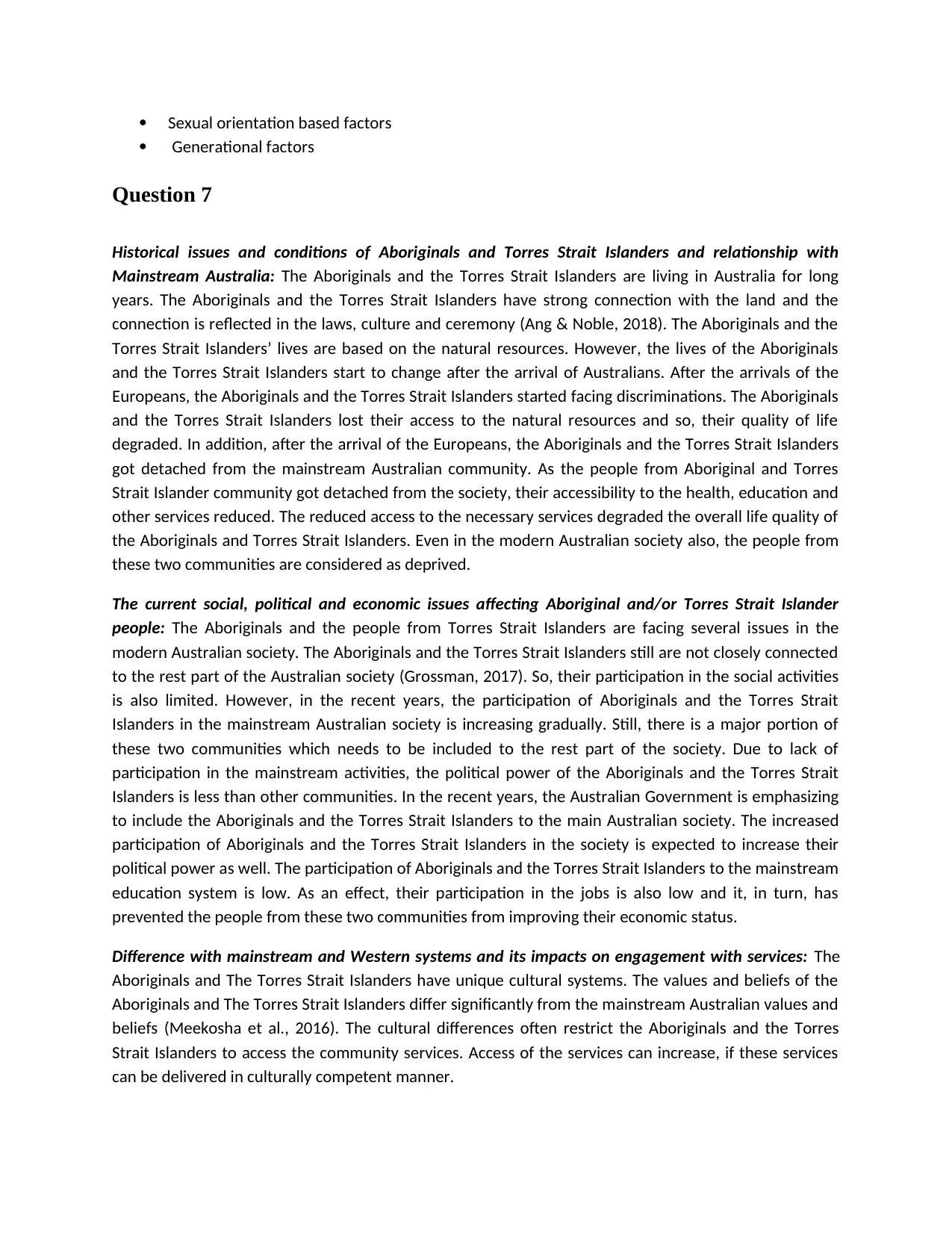
Sexual orientation based factors
Generational factors
Question 7
Historical issues and conditions of Aboriginals and Torres Strait Islanders and relationship with
Mainstream Australia: The Aboriginals and the Torres Strait Islanders are living in Australia for long
years. The Aboriginals and the Torres Strait Islanders have strong connection with the land and the
connection is reflected in the laws, culture and ceremony (Ang & Noble, 2018). The Aboriginals and the
Torres Strait Islanders’ lives are based on the natural resources. However, the lives of the Aboriginals
and the Torres Strait Islanders start to change after the arrival of Australians. After the arrivals of the
Europeans, the Aboriginals and the Torres Strait Islanders started facing discriminations. The Aboriginals
and the Torres Strait Islanders lost their access to the natural resources and so, their quality of life
degraded. In addition, after the arrival of the Europeans, the Aboriginals and the Torres Strait Islanders
got detached from the mainstream Australian community. As the people from Aboriginal and Torres
Strait Islander community got detached from the society, their accessibility to the health, education and
other services reduced. The reduced access to the necessary services degraded the overall life quality of
the Aboriginals and Torres Strait Islanders. Even in the modern Australian society also, the people from
these two communities are considered as deprived.
The current social, political and economic issues affecting Aboriginal and/or Torres Strait Islander
people: The Aboriginals and the people from Torres Strait Islanders are facing several issues in the
modern Australian society. The Aboriginals and the Torres Strait Islanders still are not closely connected
to the rest part of the Australian society (Grossman, 2017). So, their participation in the social activities
is also limited. However, in the recent years, the participation of Aboriginals and the Torres Strait
Islanders in the mainstream Australian society is increasing gradually. Still, there is a major portion of
these two communities which needs to be included to the rest part of the society. Due to lack of
participation in the mainstream activities, the political power of the Aboriginals and the Torres Strait
Islanders is less than other communities. In the recent years, the Australian Government is emphasizing
to include the Aboriginals and the Torres Strait Islanders to the main Australian society. The increased
participation of Aboriginals and the Torres Strait Islanders in the society is expected to increase their
political power as well. The participation of Aboriginals and the Torres Strait Islanders to the mainstream
education system is low. As an effect, their participation in the jobs is also low and it, in turn, has
prevented the people from these two communities from improving their economic status.
Difference with mainstream and Western systems and its impacts on engagement with services: The
Aboriginals and The Torres Strait Islanders have unique cultural systems. The values and beliefs of the
Aboriginals and The Torres Strait Islanders differ significantly from the mainstream Australian values and
beliefs (Meekosha et al., 2016). The cultural differences often restrict the Aboriginals and the Torres
Strait Islanders to access the community services. Access of the services can increase, if these services
can be delivered in culturally competent manner.
Generational factors
Question 7
Historical issues and conditions of Aboriginals and Torres Strait Islanders and relationship with
Mainstream Australia: The Aboriginals and the Torres Strait Islanders are living in Australia for long
years. The Aboriginals and the Torres Strait Islanders have strong connection with the land and the
connection is reflected in the laws, culture and ceremony (Ang & Noble, 2018). The Aboriginals and the
Torres Strait Islanders’ lives are based on the natural resources. However, the lives of the Aboriginals
and the Torres Strait Islanders start to change after the arrival of Australians. After the arrivals of the
Europeans, the Aboriginals and the Torres Strait Islanders started facing discriminations. The Aboriginals
and the Torres Strait Islanders lost their access to the natural resources and so, their quality of life
degraded. In addition, after the arrival of the Europeans, the Aboriginals and the Torres Strait Islanders
got detached from the mainstream Australian community. As the people from Aboriginal and Torres
Strait Islander community got detached from the society, their accessibility to the health, education and
other services reduced. The reduced access to the necessary services degraded the overall life quality of
the Aboriginals and Torres Strait Islanders. Even in the modern Australian society also, the people from
these two communities are considered as deprived.
The current social, political and economic issues affecting Aboriginal and/or Torres Strait Islander
people: The Aboriginals and the people from Torres Strait Islanders are facing several issues in the
modern Australian society. The Aboriginals and the Torres Strait Islanders still are not closely connected
to the rest part of the Australian society (Grossman, 2017). So, their participation in the social activities
is also limited. However, in the recent years, the participation of Aboriginals and the Torres Strait
Islanders in the mainstream Australian society is increasing gradually. Still, there is a major portion of
these two communities which needs to be included to the rest part of the society. Due to lack of
participation in the mainstream activities, the political power of the Aboriginals and the Torres Strait
Islanders is less than other communities. In the recent years, the Australian Government is emphasizing
to include the Aboriginals and the Torres Strait Islanders to the main Australian society. The increased
participation of Aboriginals and the Torres Strait Islanders in the society is expected to increase their
political power as well. The participation of Aboriginals and the Torres Strait Islanders to the mainstream
education system is low. As an effect, their participation in the jobs is also low and it, in turn, has
prevented the people from these two communities from improving their economic status.
Difference with mainstream and Western systems and its impacts on engagement with services: The
Aboriginals and The Torres Strait Islanders have unique cultural systems. The values and beliefs of the
Aboriginals and The Torres Strait Islanders differ significantly from the mainstream Australian values and
beliefs (Meekosha et al., 2016). The cultural differences often restrict the Aboriginals and the Torres
Strait Islanders to access the community services. Access of the services can increase, if these services
can be delivered in culturally competent manner.
Paraphrase This Document
Need a fresh take? Get an instant paraphrase of this document with our AI Paraphraser

References:
Ang, I., & Noble, G. (2018). Making multiculture: Australia and the ambivalent politics of
diversity. Making Culture: Commercialisation, Transnationalism, and the State of'Nationing'in
Contemporary Australia, 140-153.
Grossman, M. (2017). Re-Thinking ‘Vulnerability’in the Context of ‘Diversity’: Cross-Cultural Reform in
Policing Education and Training in Australia. In Policing Encounters with Vulnerability (pp. 119-143).
Palgrave Macmillan, Cham.
Meekosha, H., Wannan, A., & Shuttleworth, R. (2016). The politics of diversity in Australia: Extending the
role of community practice. Politics, Power and Community Development, 139.
Question 8
The marginalized groups of Australians are—
1. Lower income group
2. Indigenous people
3. Dependent and single mothers
4. Elderly people
5. Labours
6. People suffering from illness
Ang, I., & Noble, G. (2018). Making multiculture: Australia and the ambivalent politics of
diversity. Making Culture: Commercialisation, Transnationalism, and the State of'Nationing'in
Contemporary Australia, 140-153.
Grossman, M. (2017). Re-Thinking ‘Vulnerability’in the Context of ‘Diversity’: Cross-Cultural Reform in
Policing Education and Training in Australia. In Policing Encounters with Vulnerability (pp. 119-143).
Palgrave Macmillan, Cham.
Meekosha, H., Wannan, A., & Shuttleworth, R. (2016). The politics of diversity in Australia: Extending the
role of community practice. Politics, Power and Community Development, 139.
Question 8
The marginalized groups of Australians are—
1. Lower income group
2. Indigenous people
3. Dependent and single mothers
4. Elderly people
5. Labours
6. People suffering from illness
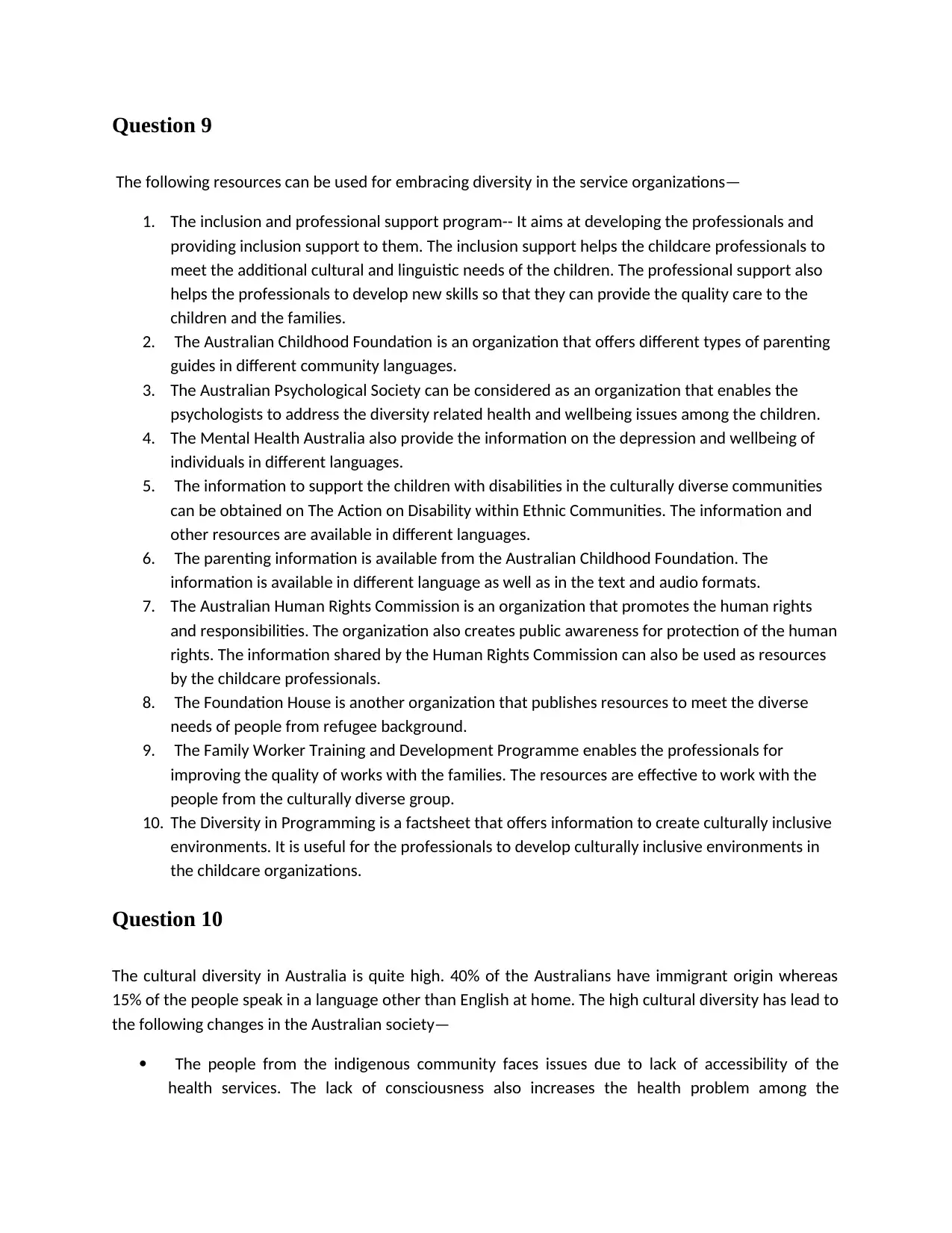
Question 9
The following resources can be used for embracing diversity in the service organizations—
1. The inclusion and professional support program-- It aims at developing the professionals and
providing inclusion support to them. The inclusion support helps the childcare professionals to
meet the additional cultural and linguistic needs of the children. The professional support also
helps the professionals to develop new skills so that they can provide the quality care to the
children and the families.
2. The Australian Childhood Foundation is an organization that offers different types of parenting
guides in different community languages.
3. The Australian Psychological Society can be considered as an organization that enables the
psychologists to address the diversity related health and wellbeing issues among the children.
4. The Mental Health Australia also provide the information on the depression and wellbeing of
individuals in different languages.
5. The information to support the children with disabilities in the culturally diverse communities
can be obtained on The Action on Disability within Ethnic Communities. The information and
other resources are available in different languages.
6. The parenting information is available from the Australian Childhood Foundation. The
information is available in different language as well as in the text and audio formats.
7. The Australian Human Rights Commission is an organization that promotes the human rights
and responsibilities. The organization also creates public awareness for protection of the human
rights. The information shared by the Human Rights Commission can also be used as resources
by the childcare professionals.
8. The Foundation House is another organization that publishes resources to meet the diverse
needs of people from refugee background.
9. The Family Worker Training and Development Programme enables the professionals for
improving the quality of works with the families. The resources are effective to work with the
people from the culturally diverse group.
10. The Diversity in Programming is a factsheet that offers information to create culturally inclusive
environments. It is useful for the professionals to develop culturally inclusive environments in
the childcare organizations.
Question 10
The cultural diversity in Australia is quite high. 40% of the Australians have immigrant origin whereas
15% of the people speak in a language other than English at home. The high cultural diversity has lead to
the following changes in the Australian society—
The people from the indigenous community faces issues due to lack of accessibility of the
health services. The lack of consciousness also increases the health problem among the
The following resources can be used for embracing diversity in the service organizations—
1. The inclusion and professional support program-- It aims at developing the professionals and
providing inclusion support to them. The inclusion support helps the childcare professionals to
meet the additional cultural and linguistic needs of the children. The professional support also
helps the professionals to develop new skills so that they can provide the quality care to the
children and the families.
2. The Australian Childhood Foundation is an organization that offers different types of parenting
guides in different community languages.
3. The Australian Psychological Society can be considered as an organization that enables the
psychologists to address the diversity related health and wellbeing issues among the children.
4. The Mental Health Australia also provide the information on the depression and wellbeing of
individuals in different languages.
5. The information to support the children with disabilities in the culturally diverse communities
can be obtained on The Action on Disability within Ethnic Communities. The information and
other resources are available in different languages.
6. The parenting information is available from the Australian Childhood Foundation. The
information is available in different language as well as in the text and audio formats.
7. The Australian Human Rights Commission is an organization that promotes the human rights
and responsibilities. The organization also creates public awareness for protection of the human
rights. The information shared by the Human Rights Commission can also be used as resources
by the childcare professionals.
8. The Foundation House is another organization that publishes resources to meet the diverse
needs of people from refugee background.
9. The Family Worker Training and Development Programme enables the professionals for
improving the quality of works with the families. The resources are effective to work with the
people from the culturally diverse group.
10. The Diversity in Programming is a factsheet that offers information to create culturally inclusive
environments. It is useful for the professionals to develop culturally inclusive environments in
the childcare organizations.
Question 10
The cultural diversity in Australia is quite high. 40% of the Australians have immigrant origin whereas
15% of the people speak in a language other than English at home. The high cultural diversity has lead to
the following changes in the Australian society—
The people from the indigenous community faces issues due to lack of accessibility of the
health services. The lack of consciousness also increases the health problem among the

aboriginal people. The health issues among the aboriginals are affecting the overall health status
of the Australian society.
The different cultural groups have different cultural identities. The differences in the values and
cultural practices are enriching the Australian society.
The cultural diversity is increasing the flow of international labors in the Australian market
(Banks, 2015). The increased supply of labor has increased the productivity, the labor
participation. The increased number of workers is benefitting the nation in terms of taxation.
The international labors are increasing diversity in the workforce. The higher diversity is
influencing the businesses positively and the enhanced business growth is leading to the
economic prosperity.
The cultural diversity is leading to development of the education industry also. The cultural
diversity is attracting the international students and it is leading to development of the
education.
References:
Banks, J. A. (2015). Cultural diversity and education. Routledge.
Question 11
The diversity practice impacts the personal behaviour, interpersonal relationship, social expectation and
perceptions of an individual in the following ways—
The diversity practice helps an individual to be respectful to the people irrespective of their culture,
ethnicity, age, ability and gender. The diversity helps the individuals to understand the faith and belief of
others and treat them with dignity. The diversity practice helps the individuals to communicate with
others in appropriate manner (Ang & Noble, 2018). The diversity practice also increases awareness of
the individuals from different background. Finally, the diversity practice is effective to avoid the
stereotypes and eliminate the biases from the regular activities. The better communication and
unbiased behaviour improves the interpersonal relationship with others. The diversity practices also
shape the expectations of an individual on the how a client relates to the service provider, the way co-
workers related to the individual, the expected professional behaviour, the way of service delivery and
the behaviour of other people involved in the process. The cultural diversity also helps the individuals to
influence the relationship with the family, the body language and the gender preferences. The diversity
practice also helps the individuals to change the perception on the external world. The diversity practice
enables an individual to value the differences among the diverse groups and respect the different
groups.
Reference:
Ang, I., & Noble, G. (2018). Making multiculture: Australia and the ambivalent politics of
diversity. Making Culture: Commercialisation, Transnationalism, and the State of'Nationing'in
Contemporary Australia, 140-153.
of the Australian society.
The different cultural groups have different cultural identities. The differences in the values and
cultural practices are enriching the Australian society.
The cultural diversity is increasing the flow of international labors in the Australian market
(Banks, 2015). The increased supply of labor has increased the productivity, the labor
participation. The increased number of workers is benefitting the nation in terms of taxation.
The international labors are increasing diversity in the workforce. The higher diversity is
influencing the businesses positively and the enhanced business growth is leading to the
economic prosperity.
The cultural diversity is leading to development of the education industry also. The cultural
diversity is attracting the international students and it is leading to development of the
education.
References:
Banks, J. A. (2015). Cultural diversity and education. Routledge.
Question 11
The diversity practice impacts the personal behaviour, interpersonal relationship, social expectation and
perceptions of an individual in the following ways—
The diversity practice helps an individual to be respectful to the people irrespective of their culture,
ethnicity, age, ability and gender. The diversity helps the individuals to understand the faith and belief of
others and treat them with dignity. The diversity practice helps the individuals to communicate with
others in appropriate manner (Ang & Noble, 2018). The diversity practice also increases awareness of
the individuals from different background. Finally, the diversity practice is effective to avoid the
stereotypes and eliminate the biases from the regular activities. The better communication and
unbiased behaviour improves the interpersonal relationship with others. The diversity practices also
shape the expectations of an individual on the how a client relates to the service provider, the way co-
workers related to the individual, the expected professional behaviour, the way of service delivery and
the behaviour of other people involved in the process. The cultural diversity also helps the individuals to
influence the relationship with the family, the body language and the gender preferences. The diversity
practice also helps the individuals to change the perception on the external world. The diversity practice
enables an individual to value the differences among the diverse groups and respect the different
groups.
Reference:
Ang, I., & Noble, G. (2018). Making multiculture: Australia and the ambivalent politics of
diversity. Making Culture: Commercialisation, Transnationalism, and the State of'Nationing'in
Contemporary Australia, 140-153.
Secure Best Marks with AI Grader
Need help grading? Try our AI Grader for instant feedback on your assignments.

.
Summative assessment 2
In the modern workplaces, having a diverse workplace is a Forrest, J., Lean, G., & Dunn, K. (2016).
Challenging racism through schools: teacher attitudes to cultural diversity and multicultural education in
Sydney, Australia. Race Ethnicity and Education, 19(3), 618-638.widely used practice. The modern
organizations operate with the global community. The advancements in international travel and
communication have enabled people to move easily across the borders (Ting-Toomey & Dorjee, 2018).
Therefore, it is necessary for the contemporary workforces to adjust to the global community. The
current research focuses on analyzing the impacts of diversity on work and workplace relationships. The
research also gives importance on reflecting on the factors associated with cultural safety and
competences, biases and prejudices, the importance of having a mutually beneficial relationship with
the workmates, mitigating the communication barriers and improving social awareness.
Impact of diversity on work and work relationships:
The diversity impacts work and work relationships in various ways. Presence of a diverse workforce in
the organization fosters innovation. The individuals from different cultural background do not think in a
similar way (Banks, 2015). Therefore, developing a diverse workforce helps the businesses to promote
creative thinking at the workplace. As an effect, the organization becomes able to provide more
innovative solutions to consumers. Incorporating innovation to the products or services is also effective
for improving the profitability of the organization. The people from diverse background come with
different skills and abilities. So, by hiring the diverse talent pools, the organizations become able to
improve the products and services.
Despite the advantages, development of a diverse workforce can also be disadvantageous in several
ways. Firstly, the diversity can increase conflicts among the workforce to a great extent. While working
in a diverse workforce, the individuals can feel confused while communicating with people from other
background. The confusion among the staffs can create a negative atmosphere in the organization. As
an effect, decision-making in the organization can become difficult. Emergence of bureaucratic
environment is another adverse effect of introducing diversity in the organization (Trueba et al., 2014).
Summative assessment 2
In the modern workplaces, having a diverse workplace is a Forrest, J., Lean, G., & Dunn, K. (2016).
Challenging racism through schools: teacher attitudes to cultural diversity and multicultural education in
Sydney, Australia. Race Ethnicity and Education, 19(3), 618-638.widely used practice. The modern
organizations operate with the global community. The advancements in international travel and
communication have enabled people to move easily across the borders (Ting-Toomey & Dorjee, 2018).
Therefore, it is necessary for the contemporary workforces to adjust to the global community. The
current research focuses on analyzing the impacts of diversity on work and workplace relationships. The
research also gives importance on reflecting on the factors associated with cultural safety and
competences, biases and prejudices, the importance of having a mutually beneficial relationship with
the workmates, mitigating the communication barriers and improving social awareness.
Impact of diversity on work and work relationships:
The diversity impacts work and work relationships in various ways. Presence of a diverse workforce in
the organization fosters innovation. The individuals from different cultural background do not think in a
similar way (Banks, 2015). Therefore, developing a diverse workforce helps the businesses to promote
creative thinking at the workplace. As an effect, the organization becomes able to provide more
innovative solutions to consumers. Incorporating innovation to the products or services is also effective
for improving the profitability of the organization. The people from diverse background come with
different skills and abilities. So, by hiring the diverse talent pools, the organizations become able to
improve the products and services.
Despite the advantages, development of a diverse workforce can also be disadvantageous in several
ways. Firstly, the diversity can increase conflicts among the workforce to a great extent. While working
in a diverse workforce, the individuals can feel confused while communicating with people from other
background. The confusion among the staffs can create a negative atmosphere in the organization. As
an effect, decision-making in the organization can become difficult. Emergence of bureaucratic
environment is another adverse effect of introducing diversity in the organization (Trueba et al., 2014).

In the modern organizations, the decisions are taken after considering different views and opinions. The
difference between views and opinions increase further with the increase in diversity of the
organizations. As an effect, the decision making becomes highly time-consuming in the highly diverse
organization. Therefore, in such organizations, there is a risk of developing bureaucratic environment.
Extensive diversity in the organization can cause lack of team spirit. When the workforce is highly
diverse, people in the group lack common things and the similarities. As an effect, the team-spirit is
affected severely. The productivity of a team is significantly dependent on the collaboration among the
members. Lack of similarity, reduces the degree of collaboration among team-members and it, in turn,
can affect the productivity. Finally, higher degree of diversity can affect the authority and protocols in an
organization. The diverse workforce may come with several ideas on running and managing the
business. As an effect, there is a risk that the management can lose authority.
Need for inclusivity, cultural safety and cultural competence:
Need for inclusivity: An inclusive workplace gives importance on providing equal opportunity to all the
employees irrespective of the age, gender, ability, varied background, sexual orientation and religion
(Liu et al., 2014). Promoting inclusivity is important for making the employees able to utilize their full
potential to the work without any discrimination. The inclusive workplace also recognizes the fact that
an employee can have multiple identities. In other words, promoting inclusivity in an organization is
important for the following reasons—
• For recognizing, appreciating and utilizing the unique perspectives and insights of others
• Avoiding discrimination and disrespectful behaviour towards the employees
• Developing an environment of respect, trust and tolerance in the organization
Need for cultural safety:
The cultural safety in an organization is important for creating an environment where the individuals
can safely practice their culture. The cultural safety is also needed to ensure that the individuals are not
being assaulted, challenged or experiencing any form of denial because of their cultural background
(Hall et al., 2014). The cultural safety also creates an environment where the individuals respect each
other, share the knowledge and experience. The cultural safety also enables the individuals to learn with
dignity and listen to each other.
The cultural safety in an organization helps the individuals to incorporate own cultural values and
beliefs at the workplace. The cultural safety also reduces the risk of discrimination among employees on
basis of the cultural background. Finally, cultural safety also creates an environment where the
employees understand each others’ differences and collaborate with each other despite the differences.
Need for cultural competence:
The cultural competence is important in an organization to interact with individuals of a different
culture. Being culturally competent is necessary for maintaining a collaborative environment in the
difference between views and opinions increase further with the increase in diversity of the
organizations. As an effect, the decision making becomes highly time-consuming in the highly diverse
organization. Therefore, in such organizations, there is a risk of developing bureaucratic environment.
Extensive diversity in the organization can cause lack of team spirit. When the workforce is highly
diverse, people in the group lack common things and the similarities. As an effect, the team-spirit is
affected severely. The productivity of a team is significantly dependent on the collaboration among the
members. Lack of similarity, reduces the degree of collaboration among team-members and it, in turn,
can affect the productivity. Finally, higher degree of diversity can affect the authority and protocols in an
organization. The diverse workforce may come with several ideas on running and managing the
business. As an effect, there is a risk that the management can lose authority.
Need for inclusivity, cultural safety and cultural competence:
Need for inclusivity: An inclusive workplace gives importance on providing equal opportunity to all the
employees irrespective of the age, gender, ability, varied background, sexual orientation and religion
(Liu et al., 2014). Promoting inclusivity is important for making the employees able to utilize their full
potential to the work without any discrimination. The inclusive workplace also recognizes the fact that
an employee can have multiple identities. In other words, promoting inclusivity in an organization is
important for the following reasons—
• For recognizing, appreciating and utilizing the unique perspectives and insights of others
• Avoiding discrimination and disrespectful behaviour towards the employees
• Developing an environment of respect, trust and tolerance in the organization
Need for cultural safety:
The cultural safety in an organization is important for creating an environment where the individuals
can safely practice their culture. The cultural safety is also needed to ensure that the individuals are not
being assaulted, challenged or experiencing any form of denial because of their cultural background
(Hall et al., 2014). The cultural safety also creates an environment where the individuals respect each
other, share the knowledge and experience. The cultural safety also enables the individuals to learn with
dignity and listen to each other.
The cultural safety in an organization helps the individuals to incorporate own cultural values and
beliefs at the workplace. The cultural safety also reduces the risk of discrimination among employees on
basis of the cultural background. Finally, cultural safety also creates an environment where the
employees understand each others’ differences and collaborate with each other despite the differences.
Need for cultural competence:
The cultural competence is important in an organization to interact with individuals of a different
culture. Being culturally competent is necessary for maintaining a collaborative environment in the
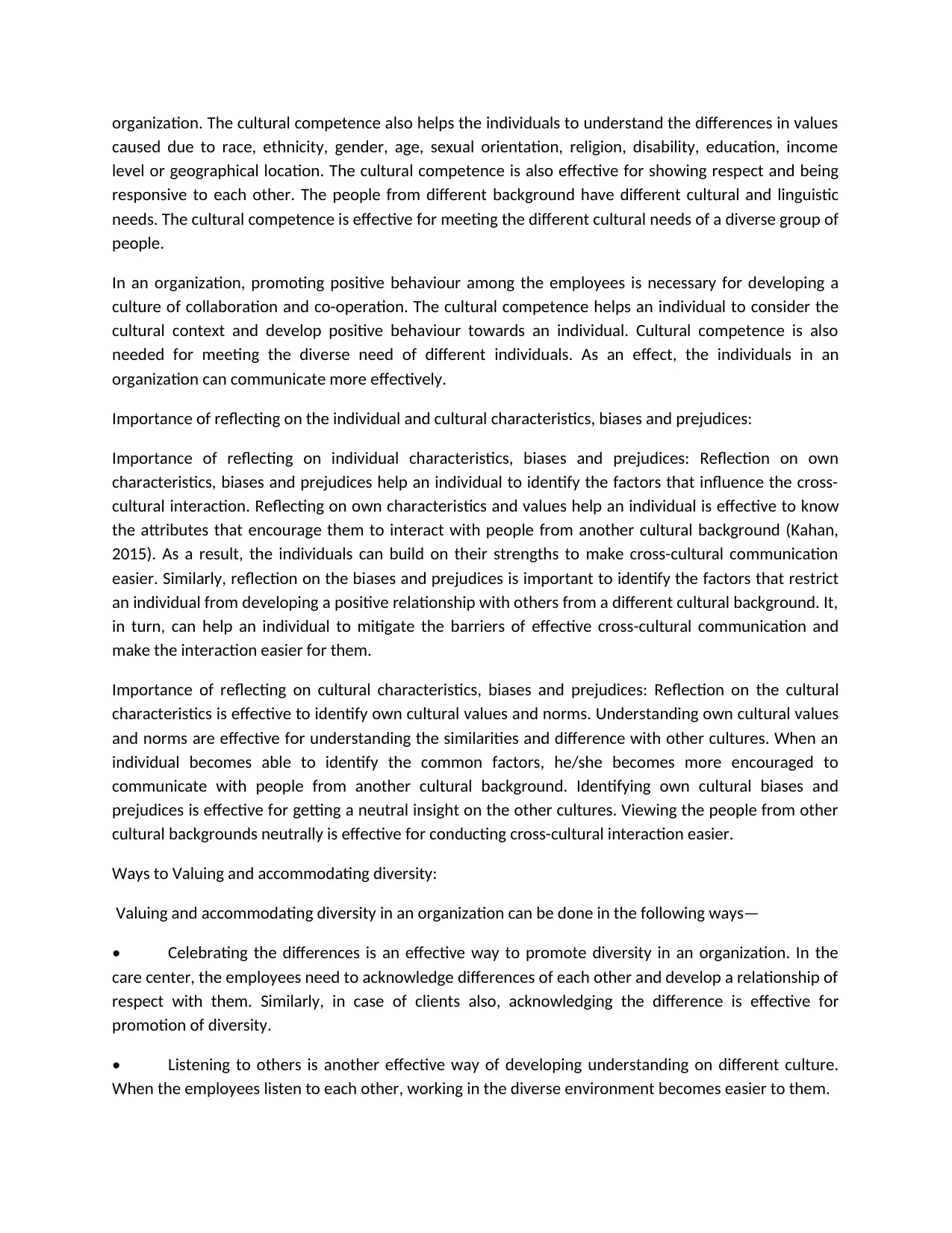
organization. The cultural competence also helps the individuals to understand the differences in values
caused due to race, ethnicity, gender, age, sexual orientation, religion, disability, education, income
level or geographical location. The cultural competence is also effective for showing respect and being
responsive to each other. The people from different background have different cultural and linguistic
needs. The cultural competence is effective for meeting the different cultural needs of a diverse group of
people.
In an organization, promoting positive behaviour among the employees is necessary for developing a
culture of collaboration and co-operation. The cultural competence helps an individual to consider the
cultural context and develop positive behaviour towards an individual. Cultural competence is also
needed for meeting the diverse need of different individuals. As an effect, the individuals in an
organization can communicate more effectively.
Importance of reflecting on the individual and cultural characteristics, biases and prejudices:
Importance of reflecting on individual characteristics, biases and prejudices: Reflection on own
characteristics, biases and prejudices help an individual to identify the factors that influence the cross-
cultural interaction. Reflecting on own characteristics and values help an individual is effective to know
the attributes that encourage them to interact with people from another cultural background (Kahan,
2015). As a result, the individuals can build on their strengths to make cross-cultural communication
easier. Similarly, reflection on the biases and prejudices is important to identify the factors that restrict
an individual from developing a positive relationship with others from a different cultural background. It,
in turn, can help an individual to mitigate the barriers of effective cross-cultural communication and
make the interaction easier for them.
Importance of reflecting on cultural characteristics, biases and prejudices: Reflection on the cultural
characteristics is effective to identify own cultural values and norms. Understanding own cultural values
and norms are effective for understanding the similarities and difference with other cultures. When an
individual becomes able to identify the common factors, he/she becomes more encouraged to
communicate with people from another cultural background. Identifying own cultural biases and
prejudices is effective for getting a neutral insight on the other cultures. Viewing the people from other
cultural backgrounds neutrally is effective for conducting cross-cultural interaction easier.
Ways to Valuing and accommodating diversity:
Valuing and accommodating diversity in an organization can be done in the following ways—
• Celebrating the differences is an effective way to promote diversity in an organization. In the
care center, the employees need to acknowledge differences of each other and develop a relationship of
respect with them. Similarly, in case of clients also, acknowledging the difference is effective for
promotion of diversity.
• Listening to others is another effective way of developing understanding on different culture.
When the employees listen to each other, working in the diverse environment becomes easier to them.
caused due to race, ethnicity, gender, age, sexual orientation, religion, disability, education, income
level or geographical location. The cultural competence is also effective for showing respect and being
responsive to each other. The people from different background have different cultural and linguistic
needs. The cultural competence is effective for meeting the different cultural needs of a diverse group of
people.
In an organization, promoting positive behaviour among the employees is necessary for developing a
culture of collaboration and co-operation. The cultural competence helps an individual to consider the
cultural context and develop positive behaviour towards an individual. Cultural competence is also
needed for meeting the diverse need of different individuals. As an effect, the individuals in an
organization can communicate more effectively.
Importance of reflecting on the individual and cultural characteristics, biases and prejudices:
Importance of reflecting on individual characteristics, biases and prejudices: Reflection on own
characteristics, biases and prejudices help an individual to identify the factors that influence the cross-
cultural interaction. Reflecting on own characteristics and values help an individual is effective to know
the attributes that encourage them to interact with people from another cultural background (Kahan,
2015). As a result, the individuals can build on their strengths to make cross-cultural communication
easier. Similarly, reflection on the biases and prejudices is important to identify the factors that restrict
an individual from developing a positive relationship with others from a different cultural background. It,
in turn, can help an individual to mitigate the barriers of effective cross-cultural communication and
make the interaction easier for them.
Importance of reflecting on cultural characteristics, biases and prejudices: Reflection on the cultural
characteristics is effective to identify own cultural values and norms. Understanding own cultural values
and norms are effective for understanding the similarities and difference with other cultures. When an
individual becomes able to identify the common factors, he/she becomes more encouraged to
communicate with people from another cultural background. Identifying own cultural biases and
prejudices is effective for getting a neutral insight on the other cultures. Viewing the people from other
cultural backgrounds neutrally is effective for conducting cross-cultural interaction easier.
Ways to Valuing and accommodating diversity:
Valuing and accommodating diversity in an organization can be done in the following ways—
• Celebrating the differences is an effective way to promote diversity in an organization. In the
care center, the employees need to acknowledge differences of each other and develop a relationship of
respect with them. Similarly, in case of clients also, acknowledging the difference is effective for
promotion of diversity.
• Listening to others is another effective way of developing understanding on different culture.
When the employees listen to each other, working in the diverse environment becomes easier to them.
Paraphrase This Document
Need a fresh take? Get an instant paraphrase of this document with our AI Paraphraser
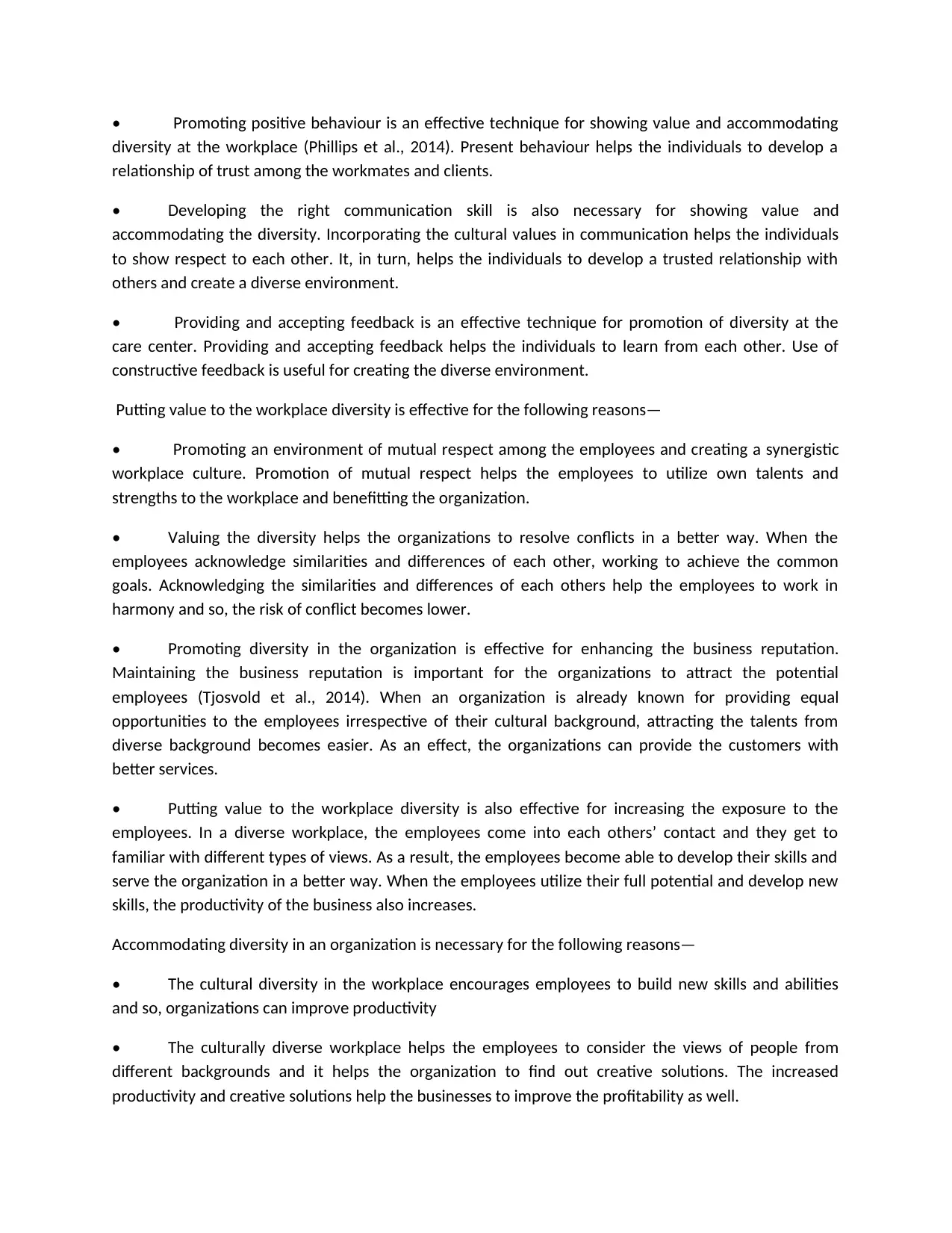
• Promoting positive behaviour is an effective technique for showing value and accommodating
diversity at the workplace (Phillips et al., 2014). Present behaviour helps the individuals to develop a
relationship of trust among the workmates and clients.
• Developing the right communication skill is also necessary for showing value and
accommodating the diversity. Incorporating the cultural values in communication helps the individuals
to show respect to each other. It, in turn, helps the individuals to develop a trusted relationship with
others and create a diverse environment.
• Providing and accepting feedback is an effective technique for promotion of diversity at the
care center. Providing and accepting feedback helps the individuals to learn from each other. Use of
constructive feedback is useful for creating the diverse environment.
Putting value to the workplace diversity is effective for the following reasons—
• Promoting an environment of mutual respect among the employees and creating a synergistic
workplace culture. Promotion of mutual respect helps the employees to utilize own talents and
strengths to the workplace and benefitting the organization.
• Valuing the diversity helps the organizations to resolve conflicts in a better way. When the
employees acknowledge similarities and differences of each other, working to achieve the common
goals. Acknowledging the similarities and differences of each others help the employees to work in
harmony and so, the risk of conflict becomes lower.
• Promoting diversity in the organization is effective for enhancing the business reputation.
Maintaining the business reputation is important for the organizations to attract the potential
employees (Tjosvold et al., 2014). When an organization is already known for providing equal
opportunities to the employees irrespective of their cultural background, attracting the talents from
diverse background becomes easier. As an effect, the organizations can provide the customers with
better services.
• Putting value to the workplace diversity is also effective for increasing the exposure to the
employees. In a diverse workplace, the employees come into each others’ contact and they get to
familiar with different types of views. As a result, the employees become able to develop their skills and
serve the organization in a better way. When the employees utilize their full potential and develop new
skills, the productivity of the business also increases.
Accommodating diversity in an organization is necessary for the following reasons—
• The cultural diversity in the workplace encourages employees to build new skills and abilities
and so, organizations can improve productivity
• The culturally diverse workplace helps the employees to consider the views of people from
different backgrounds and it helps the organization to find out creative solutions. The increased
productivity and creative solutions help the businesses to improve the profitability as well.
diversity at the workplace (Phillips et al., 2014). Present behaviour helps the individuals to develop a
relationship of trust among the workmates and clients.
• Developing the right communication skill is also necessary for showing value and
accommodating the diversity. Incorporating the cultural values in communication helps the individuals
to show respect to each other. It, in turn, helps the individuals to develop a trusted relationship with
others and create a diverse environment.
• Providing and accepting feedback is an effective technique for promotion of diversity at the
care center. Providing and accepting feedback helps the individuals to learn from each other. Use of
constructive feedback is useful for creating the diverse environment.
Putting value to the workplace diversity is effective for the following reasons—
• Promoting an environment of mutual respect among the employees and creating a synergistic
workplace culture. Promotion of mutual respect helps the employees to utilize own talents and
strengths to the workplace and benefitting the organization.
• Valuing the diversity helps the organizations to resolve conflicts in a better way. When the
employees acknowledge similarities and differences of each other, working to achieve the common
goals. Acknowledging the similarities and differences of each others help the employees to work in
harmony and so, the risk of conflict becomes lower.
• Promoting diversity in the organization is effective for enhancing the business reputation.
Maintaining the business reputation is important for the organizations to attract the potential
employees (Tjosvold et al., 2014). When an organization is already known for providing equal
opportunities to the employees irrespective of their cultural background, attracting the talents from
diverse background becomes easier. As an effect, the organizations can provide the customers with
better services.
• Putting value to the workplace diversity is also effective for increasing the exposure to the
employees. In a diverse workplace, the employees come into each others’ contact and they get to
familiar with different types of views. As a result, the employees become able to develop their skills and
serve the organization in a better way. When the employees utilize their full potential and develop new
skills, the productivity of the business also increases.
Accommodating diversity in an organization is necessary for the following reasons—
• The cultural diversity in the workplace encourages employees to build new skills and abilities
and so, organizations can improve productivity
• The culturally diverse workplace helps the employees to consider the views of people from
different backgrounds and it helps the organization to find out creative solutions. The increased
productivity and creative solutions help the businesses to improve the profitability as well.

• Promoting diversity helps organizations to provide each employee with equal growth and
development opportunities. As the employees get the chance to develop themselves, their engagement
to the organization increases. Promoting diversity is effective for maintaining an image of the
organization, reducing conflict in the workplace and retaining the employees.
Ways to develop effective and mutually beneficial relationships with workmates, clients and clients’
families:
The effective and mutually beneficial relationship can be developed among the workmates, clients and
clients’ families in the following ways—
• Conducting a regular discussion with stakeholders such as workmates, clients and the families is
useful for developing a mutually beneficial relationship. During the discussion, every stakeholder
becomes able to share own views and it helps them to learn from each other. The discussion is also
effective for developing strategies upon considering the context of every stakeholder.
• Learning about each other is another effective way of developing a mutually beneficial
relationship with the stakeholders. When each and every member of the group knows about each
other’s unique attributes, communicating becomes easier.
Overcoming communication barriers:
The communication style of the individuals changes along with the culture. Therefore, in a highly diverse
environment, different individuals can have different style of communication and it can cause barriers
for free information flow. In order to serve the clients and their families effectively and maintain an
environment of collaboration, promoting free communication is necessary. The communication barriers
in a diverse environment can be mitigated in the following ways—
• Learning the culture of others is necessary for improving the communication among people
from different background. Knowledge on others’ culture is effective for knowing the standard practices
for communication. When the individuals are aware of the cultural norms communicating becomes
easier.
• Knowing some key phrases of others’ language is necessary for fostering effective
communication. Using the key phrases at the time of communication helps the individuals to mitigate
the linguistic barriers. It, in turn, is effective for promoting more effective information sharing.
• Avoiding the stereotypes and viewing the individuals of any cultural background neutrally is
effective for improving the communication. The stereotyped ideas can prevent the individuals from
obtaining the actual insight of others (Iorio & Taylor, 2014). Possessing a biased or improper image on
people from other cultures can restrict an individual from developing positive relationship with others.
Diversity training can be effective to help the individuals to know about the people from other cultures.
It helps them to get the actual insight of the other cultures and communicate effectively.
Accommodating and respecting individual and cultural needs:
development opportunities. As the employees get the chance to develop themselves, their engagement
to the organization increases. Promoting diversity is effective for maintaining an image of the
organization, reducing conflict in the workplace and retaining the employees.
Ways to develop effective and mutually beneficial relationships with workmates, clients and clients’
families:
The effective and mutually beneficial relationship can be developed among the workmates, clients and
clients’ families in the following ways—
• Conducting a regular discussion with stakeholders such as workmates, clients and the families is
useful for developing a mutually beneficial relationship. During the discussion, every stakeholder
becomes able to share own views and it helps them to learn from each other. The discussion is also
effective for developing strategies upon considering the context of every stakeholder.
• Learning about each other is another effective way of developing a mutually beneficial
relationship with the stakeholders. When each and every member of the group knows about each
other’s unique attributes, communicating becomes easier.
Overcoming communication barriers:
The communication style of the individuals changes along with the culture. Therefore, in a highly diverse
environment, different individuals can have different style of communication and it can cause barriers
for free information flow. In order to serve the clients and their families effectively and maintain an
environment of collaboration, promoting free communication is necessary. The communication barriers
in a diverse environment can be mitigated in the following ways—
• Learning the culture of others is necessary for improving the communication among people
from different background. Knowledge on others’ culture is effective for knowing the standard practices
for communication. When the individuals are aware of the cultural norms communicating becomes
easier.
• Knowing some key phrases of others’ language is necessary for fostering effective
communication. Using the key phrases at the time of communication helps the individuals to mitigate
the linguistic barriers. It, in turn, is effective for promoting more effective information sharing.
• Avoiding the stereotypes and viewing the individuals of any cultural background neutrally is
effective for improving the communication. The stereotyped ideas can prevent the individuals from
obtaining the actual insight of others (Iorio & Taylor, 2014). Possessing a biased or improper image on
people from other cultures can restrict an individual from developing positive relationship with others.
Diversity training can be effective to help the individuals to know about the people from other cultures.
It helps them to get the actual insight of the other cultures and communicate effectively.
Accommodating and respecting individual and cultural needs:
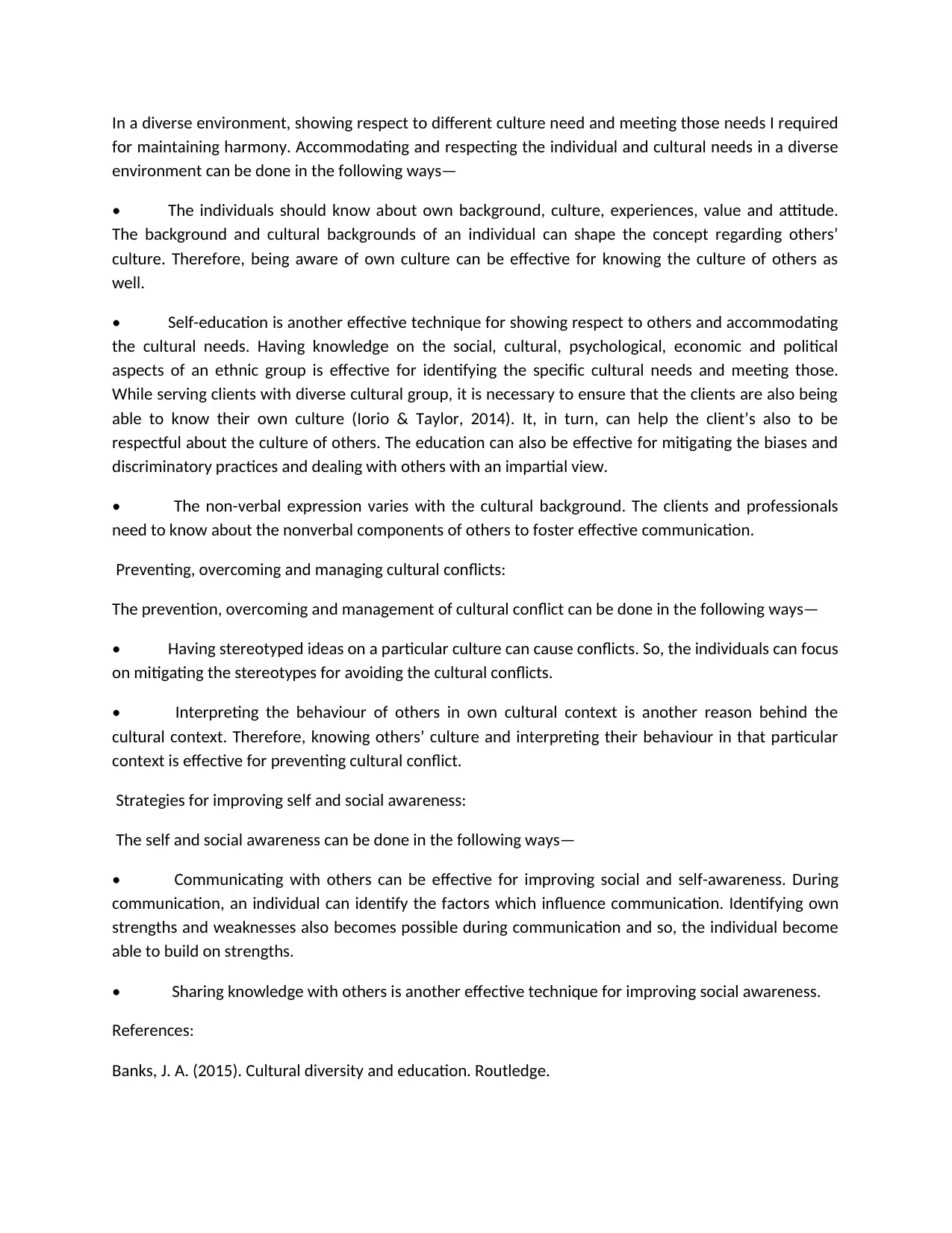
In a diverse environment, showing respect to different culture need and meeting those needs I required
for maintaining harmony. Accommodating and respecting the individual and cultural needs in a diverse
environment can be done in the following ways—
• The individuals should know about own background, culture, experiences, value and attitude.
The background and cultural backgrounds of an individual can shape the concept regarding others’
culture. Therefore, being aware of own culture can be effective for knowing the culture of others as
well.
• Self-education is another effective technique for showing respect to others and accommodating
the cultural needs. Having knowledge on the social, cultural, psychological, economic and political
aspects of an ethnic group is effective for identifying the specific cultural needs and meeting those.
While serving clients with diverse cultural group, it is necessary to ensure that the clients are also being
able to know their own culture (Iorio & Taylor, 2014). It, in turn, can help the client’s also to be
respectful about the culture of others. The education can also be effective for mitigating the biases and
discriminatory practices and dealing with others with an impartial view.
• The non-verbal expression varies with the cultural background. The clients and professionals
need to know about the nonverbal components of others to foster effective communication.
Preventing, overcoming and managing cultural conflicts:
The prevention, overcoming and management of cultural conflict can be done in the following ways—
• Having stereotyped ideas on a particular culture can cause conflicts. So, the individuals can focus
on mitigating the stereotypes for avoiding the cultural conflicts.
• Interpreting the behaviour of others in own cultural context is another reason behind the
cultural context. Therefore, knowing others’ culture and interpreting their behaviour in that particular
context is effective for preventing cultural conflict.
Strategies for improving self and social awareness:
The self and social awareness can be done in the following ways—
• Communicating with others can be effective for improving social and self-awareness. During
communication, an individual can identify the factors which influence communication. Identifying own
strengths and weaknesses also becomes possible during communication and so, the individual become
able to build on strengths.
• Sharing knowledge with others is another effective technique for improving social awareness.
References:
Banks, J. A. (2015). Cultural diversity and education. Routledge.
for maintaining harmony. Accommodating and respecting the individual and cultural needs in a diverse
environment can be done in the following ways—
• The individuals should know about own background, culture, experiences, value and attitude.
The background and cultural backgrounds of an individual can shape the concept regarding others’
culture. Therefore, being aware of own culture can be effective for knowing the culture of others as
well.
• Self-education is another effective technique for showing respect to others and accommodating
the cultural needs. Having knowledge on the social, cultural, psychological, economic and political
aspects of an ethnic group is effective for identifying the specific cultural needs and meeting those.
While serving clients with diverse cultural group, it is necessary to ensure that the clients are also being
able to know their own culture (Iorio & Taylor, 2014). It, in turn, can help the client’s also to be
respectful about the culture of others. The education can also be effective for mitigating the biases and
discriminatory practices and dealing with others with an impartial view.
• The non-verbal expression varies with the cultural background. The clients and professionals
need to know about the nonverbal components of others to foster effective communication.
Preventing, overcoming and managing cultural conflicts:
The prevention, overcoming and management of cultural conflict can be done in the following ways—
• Having stereotyped ideas on a particular culture can cause conflicts. So, the individuals can focus
on mitigating the stereotypes for avoiding the cultural conflicts.
• Interpreting the behaviour of others in own cultural context is another reason behind the
cultural context. Therefore, knowing others’ culture and interpreting their behaviour in that particular
context is effective for preventing cultural conflict.
Strategies for improving self and social awareness:
The self and social awareness can be done in the following ways—
• Communicating with others can be effective for improving social and self-awareness. During
communication, an individual can identify the factors which influence communication. Identifying own
strengths and weaknesses also becomes possible during communication and so, the individual become
able to build on strengths.
• Sharing knowledge with others is another effective technique for improving social awareness.
References:
Banks, J. A. (2015). Cultural diversity and education. Routledge.
Secure Best Marks with AI Grader
Need help grading? Try our AI Grader for instant feedback on your assignments.
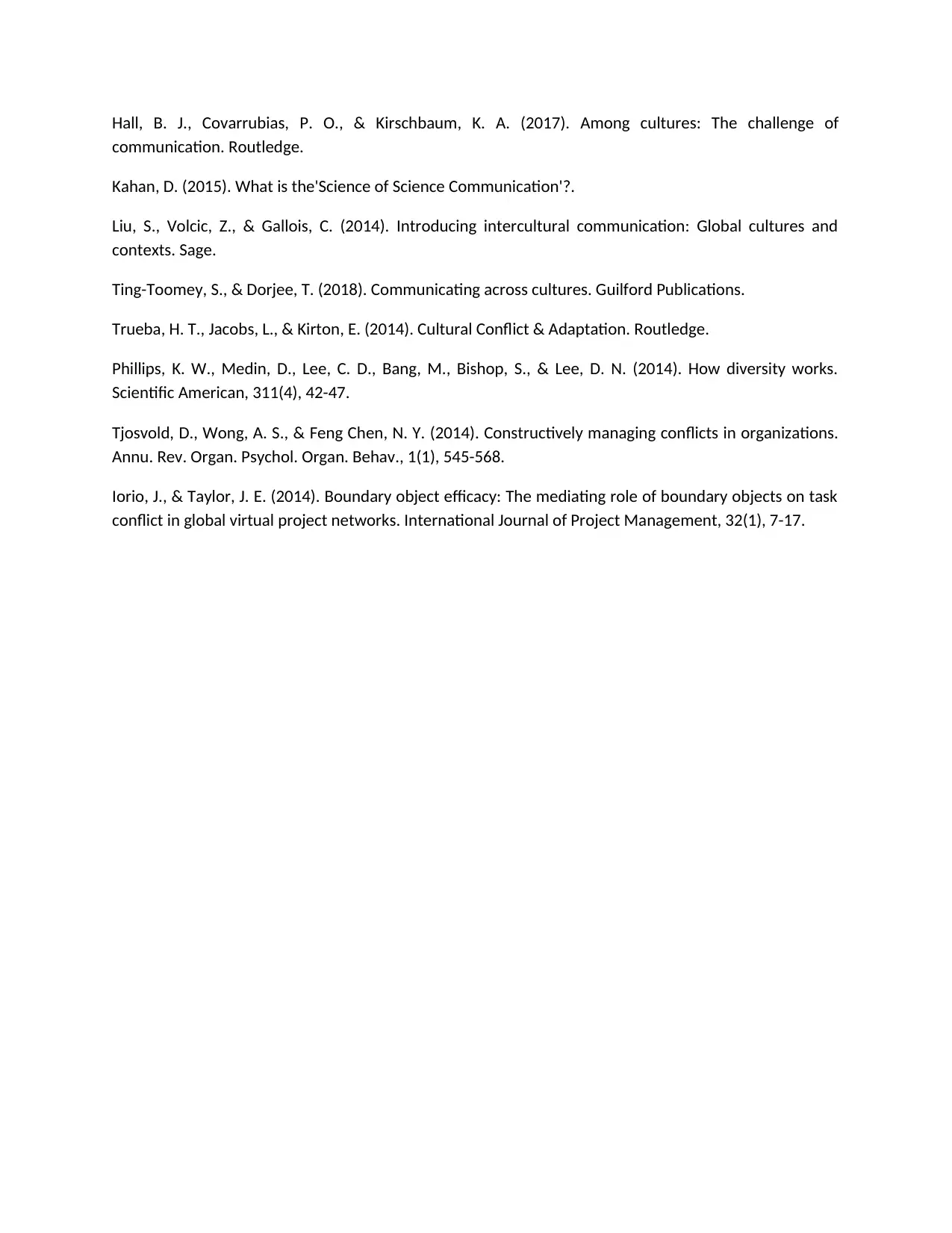
Hall, B. J., Covarrubias, P. O., & Kirschbaum, K. A. (2017). Among cultures: The challenge of
communication. Routledge.
Kahan, D. (2015). What is the'Science of Science Communication'?.
Liu, S., Volcic, Z., & Gallois, C. (2014). Introducing intercultural communication: Global cultures and
contexts. Sage.
Ting-Toomey, S., & Dorjee, T. (2018). Communicating across cultures. Guilford Publications.
Trueba, H. T., Jacobs, L., & Kirton, E. (2014). Cultural Conflict & Adaptation. Routledge.
Phillips, K. W., Medin, D., Lee, C. D., Bang, M., Bishop, S., & Lee, D. N. (2014). How diversity works.
Scientific American, 311(4), 42-47.
Tjosvold, D., Wong, A. S., & Feng Chen, N. Y. (2014). Constructively managing conflicts in organizations.
Annu. Rev. Organ. Psychol. Organ. Behav., 1(1), 545-568.
Iorio, J., & Taylor, J. E. (2014). Boundary object efficacy: The mediating role of boundary objects on task
conflict in global virtual project networks. International Journal of Project Management, 32(1), 7-17.
communication. Routledge.
Kahan, D. (2015). What is the'Science of Science Communication'?.
Liu, S., Volcic, Z., & Gallois, C. (2014). Introducing intercultural communication: Global cultures and
contexts. Sage.
Ting-Toomey, S., & Dorjee, T. (2018). Communicating across cultures. Guilford Publications.
Trueba, H. T., Jacobs, L., & Kirton, E. (2014). Cultural Conflict & Adaptation. Routledge.
Phillips, K. W., Medin, D., Lee, C. D., Bang, M., Bishop, S., & Lee, D. N. (2014). How diversity works.
Scientific American, 311(4), 42-47.
Tjosvold, D., Wong, A. S., & Feng Chen, N. Y. (2014). Constructively managing conflicts in organizations.
Annu. Rev. Organ. Psychol. Organ. Behav., 1(1), 545-568.
Iorio, J., & Taylor, J. E. (2014). Boundary object efficacy: The mediating role of boundary objects on task
conflict in global virtual project networks. International Journal of Project Management, 32(1), 7-17.
1 out of 23
Related Documents
Your All-in-One AI-Powered Toolkit for Academic Success.
+13062052269
info@desklib.com
Available 24*7 on WhatsApp / Email
![[object Object]](/_next/static/media/star-bottom.7253800d.svg)
Unlock your academic potential
© 2024 | Zucol Services PVT LTD | All rights reserved.





